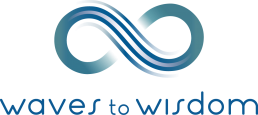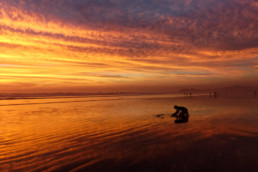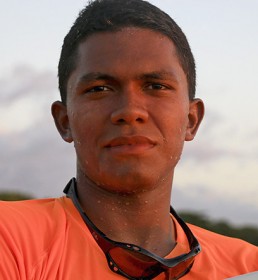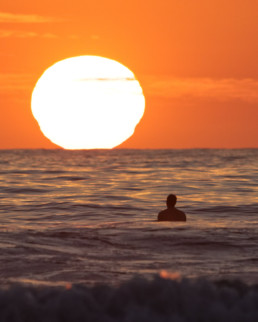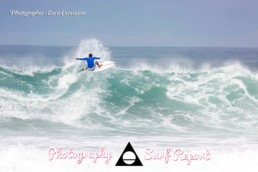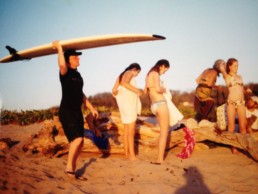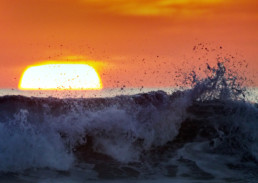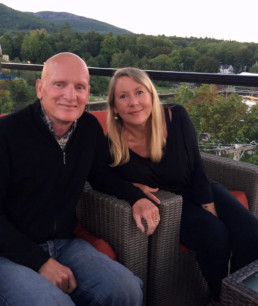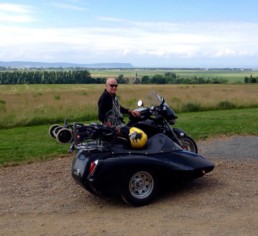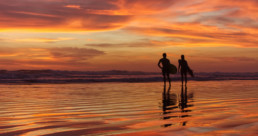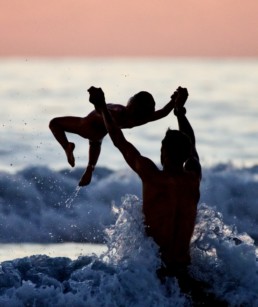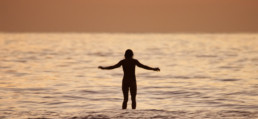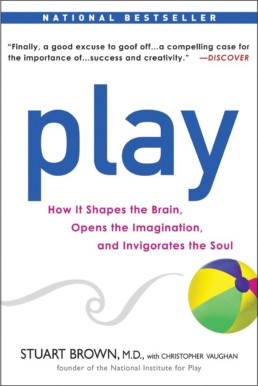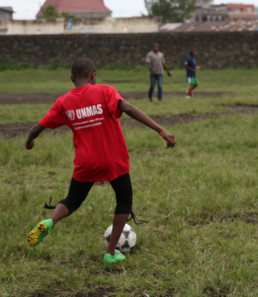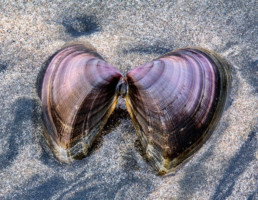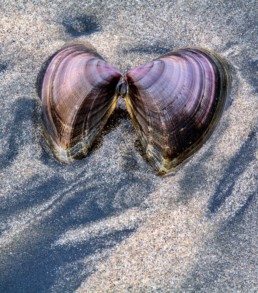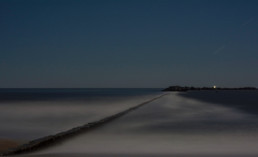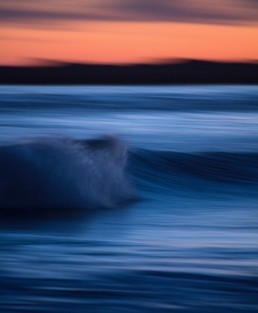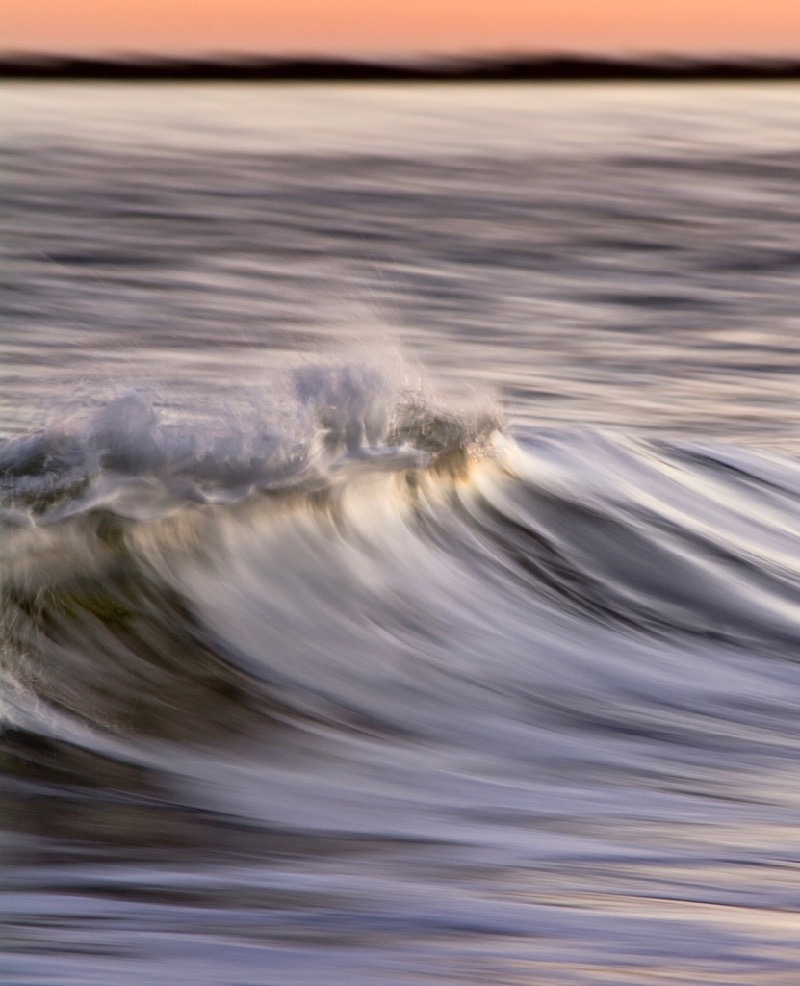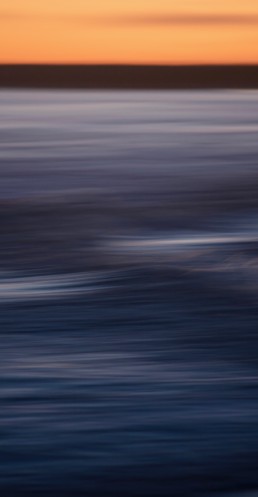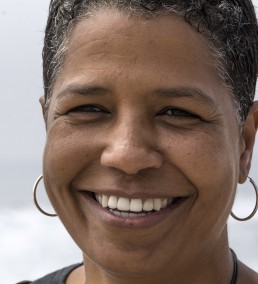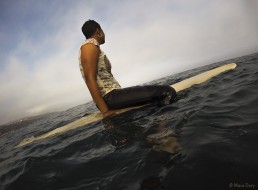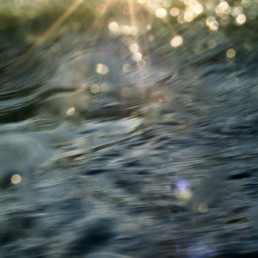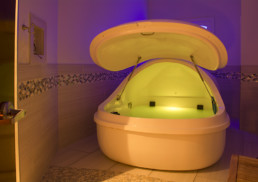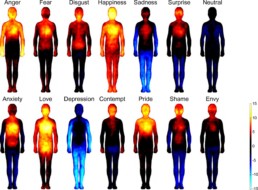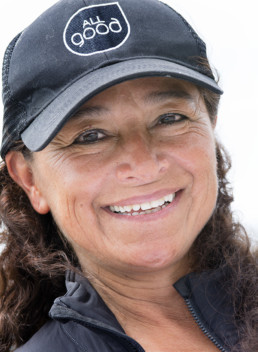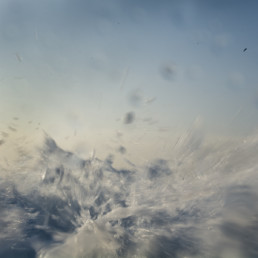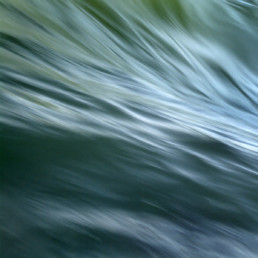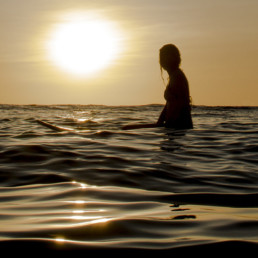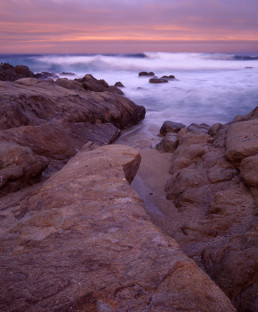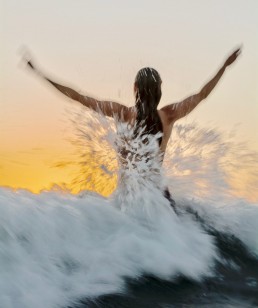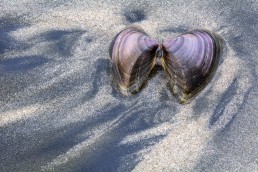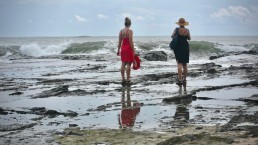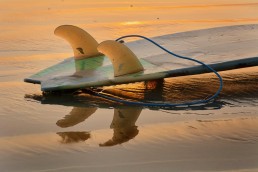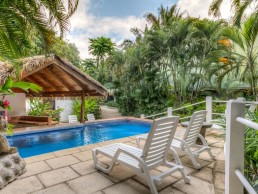Interview: Kevin Carillo
To listen to the interview, scroll to the Player at the bottom of the page.
"As a Tico Nosareño and surfer, I love this place. It’s so good. This place is magical. A lot of things that you can learn. The waves, surfing is so good. Just like taking off like just get up on the wave, it’s gonna feel like something magical inside of you, like butterflies on your belly, something like that, it’s gonna like, feels like, this is like heaven."
~Kevin Pipin Carillo
Show Notes
The ATV tour service, Pippin Rentals, Kevin and his family operate in Nosara.
The surf school where Kevin teaches, Safari Surf.
National Geographic Article on Blue Zones (where people routinely live longer than average)
Peer reviewed article about how research into Blue Zones led to this conclucion: “putting the responsibility of curating a healthy environment on an individual does not work, but through policy and environmental changes the Blue Zones Project Communities have been able to increase life expectancy, reduce obesity and make the healthy choice the easy choice for millions of Americans.”
Who to contact to book tortilla lesson when you’re visiting Nosara (Conocer)
Wikipedia Entry on Catalan
Interview Transcript
Intro Part 1
My name is Maia Dery.
The Waves to Wisdom interviews are the result of an exploration into a world I discovered when I learned to surf at mid-life.
Some of these conversations aren’t necessarily with people who we would instantly recognize as leaders but they are all leading us in a direction I instinctively followed and have benefitted tremendously in the process. Some of them don’t have huge audiences, but they are living very large lives.
To me, these people all seem to have wisdom practices centered on their relationship to the more-than-human world, to what we usually think of as “nature.”
Surfing proved first revelatory, then revolutionary in my life. I thought I was creative, thought I knew and loved water, thought I took care of my body. But when I entered the world of surfing and waves, when I started to ritualistically return to a literal edge, I realized my vision for my life had been hampered by some artificial barriers.
Slowly, with each wave and wipeout, those barriers in my brain, heart, and body began to dissolve.
I began to wonder, what if we all had a nature based practice that cracked us open? Made us more creative? Allowed us to reliably let go with the abandon of play? Of unbridled joy? What if we all practiced vulnerability, risk and failure on a daily basis and they were fun? Wouldn’t it make our lives better? Wouldn’t it lead us to the places it feels like, in this moment of planetary peril, we need to go?
Whether you find full bodied and big hearted connection through waves or walking or digging in the dirt, I hope you find these conversations useful in your own journey of re-inhabiting your life with renewed joy, deep engagement, and increasing wisdom.
Kevin: As a Tico Nosareño and surfer, I love this place. It’s so good. This place is magical. A lot of things that you can learn. The waves, surfing is so good. Just like taking off like just get up on the wave, it’s gonna feel like something magical inside of you, like butterflies on your belly, something like that, it’s gonna like, feels like, this is like heaven.
Intro Part 2
Maia: Kevin Carillo is a young surf instructor from Nosara, Costa Rica, a small jungle community dominated by American and European expatriate surfers and yogis. Over the last five years This place and the people who grew up there have,, become a strong current in my own heart, pulling me back over and over. Each time I return I learn more about the Pura Vida culture of the locals and, in turn my own culture’s predispositions leading us to define ourselves by accomplishment over relationship or work over love. The interview is with Kevin, a human but we recorded this conversation near the end of Nosara’s dry season, just a couple of days after the first rain. Along with that rain comes a gathering wave of new life, including, as you’ll hear loud and clear, crickets. It seemed fitting that, in a place where the waves, trees, hills, and wildlife are abundant, the jungle would make it’s voice heard.
Kevin’s ability to describe, in his second language, no less, the ways that the lessons he’s learned from the waves have helped him overcome stress and temptation, sort out his priorities, and grow up to be a strong, happy teacher, partner, and expectant father reminded me that wisdom is not always a result of age. Sometimes a disciplined play practice in the more than human world, something like surfing, can help us figure our lives out in what seems to me to be very brief time. Welcome to Waves to Wisdom.
Kevin: Hello Maia
Maia: Hello Kevin, will you, let’s start by telling everybody your name, your age and how long you been surfing.
Kevin: My name is Kevin Carillo. I am from Nosara, a local surfer here and I am 24 years old and I’ve been surfing for 10 years.
Maia: and did you learn from someone in your family or friends? (0:46)
Kevin: I had a friend, a classmate and he surfed, said, “Hey, you should surf!” He’s from Garza. His name is Steven. And I start surfing but just by myself. I tried by myself.
Maia: And and was it reasonably easy to learn by yourself?
Kevin: It was hard. I just remembered I just wipeout a lot on the sand.
Maia:[Laugh] But you must’ve liked it enough to continue despite the frustration.
Kevin: I know because that was the thing that you as I kid like something that you want to learn, it’s like okay I need to get this I need to get it. I need to try, doesn’t matter how hard it is, I need to get it.
Maia: And clearly you got it.
Kevin: And I got it
Maia: You got it— okay how long did it take you?
Kevin: I remember like took me like two weeks just to get up on that big board.
Maia: I’m pretty sure it took me about two years so— not too bad but I was 40 not 14 when I started. Excellent and then how long did it take you to fall in love with it?
Kevin: Since the first day.
Maia The first day even though it was frustrating [yes} you loved it right away?
Kevin: Yes, since the first day. [OK] Because I kept on going [yes] kept on going.
Maia: and and you already had a relationship with the ocean? You knew how to swim?
Kevin: I know how to swim. [okay] Yeah I knew how to swim cause here in Nosara we learn how to swim since we are like four years old. Like, little little little kids. Cause we are being on the rivers, jumping from the bridge, getting on, we call that “possas”– when the river has a little deep water, maybe a tree next to the river and we just go on the tree and jump.
Maia: And the kids love it? [yes] okay fantastic okay so you work for school, a surf school. And who do you mostly teach lessons to here in Nosara?
Kevin: Mostly beginners. A lot of beginners— just first day, trying in the whitewater and it’s like, it’s really good. I love it.
Maia: What do you love about it?
Kevin: I love the smile on their face yeah. Cause when they got that wave, when they get up, cause first they tell you, like, “I’m not good at this. I never tried this, and I’m pretty sure I’m going to not do this, since it’s the first day. “ So they have a perspective like maybe I get it but really long. You know? And when they get it since the first wave, cause sometimes they get up on the first wave, its’ like, “I got up!”
Maia: And what what sort of people, like what ages and where they from mostly?
Kevin: Mostly from the United States, there’s a lot of people from United States. There’s like an age that mostly come here to surf that is like 30 to 50. There is like a lot of people that age that want to surf.
Maia: I’ve noticed that too and I have noticed that this is a place where a lot of single women travelers seem to come to learn to surf and even older women [yes] lots of women older than I am if you can imagine that.
Kevin: Yes, it’s so good. I love that.
Maia: It’s really good, isn’t it? What do you love about it?
Kevin : That you can see that there’s no time, there’s no age but you can practice a sport, even though it’s hard, you could see like 10 feet waves and you still see old lady surfing. Or it’s small and she’s enjoying the wave you can see it doesn’t matter the age.
Maia: It doesn’t matter does it? And this beach that you teach on is a particularly good beach to learn, isn’t it?
Kevin: Yes, it’s because it’s a beach break [yes] no rocks and the wave is like small, soft, really good to learn.
Maia: So fun! The long rides here are just so fun. Do you think the fact that you were surfing as as a young boy, as a young man, did that change the way your life went in high school and afterwards?
Kevin: Of course, yes.
Maia: And it obviously, since you’re now a professional in the surf industry, it changed in that way. Did it change it any other ways, maybe earlier or affect how you made decisions or what decisions you made?
Kevin: I remember in college, like, high school I was in the last grade, just graduating to go to the University and here in Costa Rica you gotta do a final test, like five tests, like math, biology, science, English and it’s like a hard test because you don’t know what you see on the test it’s just like go and do the tests and I already surfed on the time and I remember I was so stressed out, like studying a lot. And I was like, no, I need to relax, I need to go surf, I need to be the water, take my time, see some waves, see like how it’s going to make me calm down and it helped me to win the test and I got the test and I got graduated.
Maia: It was fine. So you felt stress which you were pretty sure was gonna impede your performance, you weren’t going to do as well as you could have if you weren’t stressed. You knew by that point— you’d been surfing for four years then? Three or four years [yes, yes] and and you knew that if you went surfing that you would be able to handle that test without stress. [yeah] and so you already had that coping mechanism?
Kevin: Yes
Maia: That that sounds like wisdom right there. Good what. what other ways as a young person did surfing affect your life?
Kevin: Um Well taking decisions to be more responsible. So if you go to surf and if you don’t take the right wave you gonna wipe out, you gonna fall off.
Maia: So you learned when you were surfing that you didn’t go for every wave? [no] You had to pick the right wave for you [yes] and that translated to your life on shore. You metaphorically saw that there’s a path in life that, if you take it [yes] you’re gonna wipe out.
Kevin: Yes, you’re gonna wipe out.
Maia: No bueno. [laugh]
Kevin: No bueno. And yeah as a kid as a kid it is hard because those are things that, for a kid is really hard to take you know and like the surfing industry is like many things that you’re gonna see like drugs or alcohol, those things. So you gotta take it easy. Do the right things, go study, be responsible even though you surf still like you have other the things to do.
So, bad things you gonna see, not good friends not good friends. Friends that are going to tell you to do something, supposed to be friends right? And they going to say okay this is the surfing life. The surfing life is like, go surf, get out of the water, get changed and then go party, drink, do drugs, and maybe get a girl and then go back and wake up the next day just feeling empty and do it again. But that’s not not surfing.
Maia: That’s not surfing?
Kevin: That’s not surfing.
Maia: No. It really is for, for people who have not been here to Nosara the surf instructors are sort of alphas.Do you know that phrase? [yes] they’re in some ways they’re the people on the beach with the most status—the surf instructors. You’re all very good surfers most of you are young [yes] most of you are strong and handsome or beautiful and and there are endless waves of incoming tourists many of whom are beautiful and young and in search of a good time for the week or two that they are here.
I can imagine how for a teenage boy, or a very young man, that situation would be full of temptations—all of these people coming in with money and a desire to party. [yes] and and somehow you’ve managed to navigate all of that [yes] without, as you say, going a bad way. And you think that surfing helped you with that?
Kevin: Surfing helps, yes. It’s like if you feel like those things are going together, those bad things like what you say, like girls coming here to get party, alcohol, drugs, friends. But surfing helps like okay, relax calm down. This is not what you need to do. You need to clear your mind. Surfing like helps like clear your a lot.
Maia: So not just if you have a stressful situation like a specific test. But it sounds like if you have a larger stressful situation like figuring out how to live a life in a situation where that the bad path is easily accessible. Surfing it sounds like helped you navigate that.
Kevin: Yeah cause like you have goals right here. Surfing is like you set up goals first you’re like okay “I’m gonna get up on the board, I’m gonna turn to the side, I’m gonna cutback, I’m gonna paddle to the outside.” You’re thinking about your goals. You go little by little, doing something. It is like life, okay you need to do this thing first, it’s not like like, I’m gonna get a board, paddle out, it is not how you do it, you go little by little, take your time, set up like the right things that you need to first, and and start getting to do with those goals right? And then you’re gonna be surfing really good or you’re gonna be having a good life.
Maia: And speaking of good life, will you tell everybody your very exciting news?
Kevin: Well I’m,I’m having a baby. I’m so excited for that! Having a little boy. His name is Andreu. And I hope and I hope he gets like a good surfer. I hope he surfs. Yeah and I’m so happy to surf with him. And teach him how to surf and teach him how to live the life really good. Enjoy the life.
Maia: And when you said enjoy the life what is what is a good life to you? What is, what do you notice is a good life?
Kevin: Wake up smiling. Smiling because you are, you have a good partner on your side, a good person, with good karma, good soul and pull you up, right? With happiness. That’s a good life and go to the water, go surf at least like one hour, go surf, clear your mind, feel the sun on your face burning, especially this month, March. And enjoy the water and then like maybe go to a job, meet people, have friends, that’s a good life.
Maia That’s a good life.
Kevin: Learn some culture and eat a lot.
Maia: Eat a lot! That’s a good life!
Kevin: Yes.
Maia: There’s a concept or an expression or a way of being here that you all call Pura Vida. Could you tell anybody is listening what is Pura Vida from your perspective?
Kevin: Pura Vida is like living life in a good way. You need to live the life healthy, happy, be friendly with others, that’s Pure Vida, even though you don’t know that person, giving a smile because you don’t know what he is living. That’s Pure Vida. Like be interested in his happiness. Like like, hey hello how are you? Have a good day. That make you be a Pure Vida person and that’s the Pure Vida life here. Like we live healthy, we live happy, we love our place, we love our culture, and we take care of these little piece of land. And love the people that are here. And we help help a lot, like if if you go on the road and someone is stuck with the car that is not working broken, you stop and help him.
Maia: That’s Pure Vida.
Kevin: That’s Pure Vida.
Maia: Just so that people understand it you see a lot of people coming here from other places that don’t live in a Pure Vida way [yes] they don’t. What does that look like? What is Pura Vida the opposite of?
Kevin: People who are too stressed out, people who wants to hurt other people, they just come here, destroy this piece of land and destroy the happiness that other people are living. He’s like too stressed out, needs to relax calm down breathe.
Maia: Yeah. So you were young man and you it sounds like you you had a moment where you were probably tempted to do these bad things, to live this party lifestyle. In that moment how do you think you were able to make a good decision for yourself?
Kevin: Cause I start when I was young, in high school, so there are like friends and there are like a lot of temptation like, let’s go out, party. And I did, I went to parties and I get crazy and it was not good, I was not feeling good. I was feeling empty every single day. And like you start thinking that’s the way you need to live because everybody does that. And you think that you are doing the right things, that you’re living a good way because you have money and you are paying for going out, and you’re paying for everything that you need, but it’s not, it’s not healthy but then I realize that I need to live in a different way.
Maybe from my family? I see my family like living really good, I have a good family, especially my brother. So it’s like, graduated, work, get your house because you need a house to live and then you can get the rest. Because my mom said, this is what my mom told me all the time since I was young, like, “Get a job— study, get a job, get a house and then you can do whatever you want.”
Maia: it’s very interesting to hear that that your mother and surfing reinforced each other. Your mother said, “Take these steps in this order.” and you learn from surfing you don’t just go right out in the big waves, you have to take these steps in this order and then you don’t get hurt and that’s, that’s pretty wonderful.
So you went to college and what did you study?
Kevin: I studied to be so first I went to public university [okay] and I studied just to know English, just just to know. For two years was like from Monday to Friday. And it was like from 8 in the morning to 9 p.m. A long time just studying. Not too much for surfing, just on the weekends. So I need to get up really early on Friday or Saturday come to the beach, surf, and then late Sunday go back to study again. And then I finished that. I got a job to be a surf instructor. And the company that I’m working right now they help me a lot to get money and then pay for another career. And I studied to be a English teacher for elementary school and it’s so good.
Maia: It’s so good. So you got your degree in elementary English education? [Yes] And why is it so good? Tell me what’s so good about that?
Kevin: Because you are because your education keep your teaching kids you are teaching things that you know so you better do it good and feel good for it because that’s gonna be the future of this world.
Maia: Okay so so your little boy, Andreu, he will speak English and Spanish?
Kevin: He will speak English, Spanish, Catalan, from Barcelona, and Italian.
Maia: And Italian— so he will he will have four languages? [I know] My goodness.
Kevin: He’s gonna be a good guy, he’s gonna be a int… guy, he’s going to be really interesting.
Maia: He’s gonna be really interesting.
Kevin: Yeah all the ladies gonna be looking at him.
Maia: Yes he is going to be very attractive to whoever he wants to attract I am sure, yes so good! Okay, good so you have because you are a professional surf instructor, [yes] and by choice you could be a teacher, obviously, you are qualified to be a teacher of English but you are the teacher of surfing instead. You’ve watched a lot of people go from not being able to surf at all to be able to surf a little bit or maybe even a lot. Because one of the things I’ve noticed about your clientele your customers is that they come back. They’re so happy after coming here for one week and working with one of you, you are all such wonderful, warmhearted pure vida instructors. People, you know, by the last day sometimes they’re in tears. They don’t want to go home. [No] They’re in love with you and this place and the waves. They come back and they get better! [Yes] Even if they don’t live near waves themselves.
What have you noticed that learning to surf either through your own life or watching so many people of all ages learn to do it— what have you noticed that that does for people?
Kevin: So when they come here, some of them, well like mainly, maybe all of them? They come here, a new place, they don’t know anything about here. They just know okay, I need a place to learn how to surf and a place that help mostly for kids, right? And they come here for some surfing and they get this life here, the way that we treat them, cause we like to treat them really good. We try to give them the pura vida that we have. So they come here and it’s not only like surfing.
Maia: Okay, so in what ways do you think that these people coming to surf, how can you see it change them as they get into the water, begin this process of working with the ocean, making mistakes?
Kevin: Yeah they they come here and they get related to the ocean and they start feeling like okay it’s a good sport to try, it’s not hard, it’s easy it’s really easy, surfing, is easy if you set your goals, “Okay I’m gonna do this.” and then just do the right things, like getting up, back foot, front foot and surf the wave and they start learning little by little new things. They get interested in the surfing life. And they want to learn more. The same like me. Like, you start learning new things every single day and then not only surfing, maybe like, living here in Nosara, like living with us, with instructors, We treat them, we are like a family here. We host them like brothers, like this is my younger brother or my old brother, my sister, or sometimes like there come old ladies and we call them “Okay, Mama!” Cause you are like my mom. We are gonna treat you like you are my mom and we are happy to have you and be like a family and surf and eat and laugh.
Maia: I can attest to that because, in a lot of places that are dominated by surf culture what that winds up looking like is that those places and that culture are dominated by young men who are good at surfing, that sometimes happens, and there sometimes isn’t a place for people like me, you know a middle-aged women and that is not the case here is it is so beautiful it is like I’m your mother or your aunt or somebody su tía, su mamá, somebody important to you all. And really the pure vida is palpable, it’s a wonderful welcoming vibe all the time no matter who you are or how good or bad, technically speaking, you are at surfing. [Yes] What did surfing teach you is there anything that we haven’t talked about that surfing taught you in terms of a life lesson.
Kevin: Um, yeah, like surfing, like sometimes if you feel like you’re gonna take bad decisions surfing might help you a lot, like clear your mind, feel the ocean, feel the wind that’s going to make you calm down and think clear, think what’s better for you (3:28). And if you just do whatever seems faster, something seems faster and you just want to take it maybe it’s not the right thing. So for living, it’s like taking good decisions taking good decisions like the same wave like if you see a wave and it looks good, sometime you see a wave and it looks good it looks like a perfect wave but it’s not, it’s too short. Let’s wait for the second one or the third one. That’s the one that you need, it’s not the first one, you don’t need that one, even though it looks good but it’s not the one that will fill you up so for living you’re gonna see you like bad decisions coming up like did you take this and maybe it’s not right for you.
So that’s what happened to me like okay I need to study, I need to get a job, and then once you get that you need to get the second step and then you need a good partner with you, you need a good partner that help you that make you like grow up right? That don’t make you get stuck right there. That’s really important too. So it’s not a girl that you’re gonna find at the party and then just go out just one night And that’s the girl, no.You need to know the lady, to know the girl, surf together, yeah? surf together, know pretty well and then you do the decision. So it helped me a lot.
Maia: And tell us something about your partner
Kevin: She’s, she’s a good surfer. But I love surfing with her. I love that. And we start talking, we started exploring all the area right here in Nosara cause I’m still, I live here, but still there’s many things that you can see, like the first time. And we did some ATV tours, we went to some waterfalls and we did some trips to surf and we started talking (6:45) to know each other and then I realize that she’s a nice person cause so inspire, like, something really good that you can see through her eyes that she’s she’s so nice and, yeah, I love her a lot.
Maia: She is beautiful in every way a person can be.
Maia: and I understand your father also has an intimate relationship with the ocean.
Kevin: He’s a fisherman. He loves fishing and he taught me how to understand the ocean lot cause he knows really well the ocean because he knows really good the moon. Yeah. I don’t know but he understand the moon really, really good and if you asked I can ask him right now like what moon do we have right now he will tell you right away and he will say okay this is, the moon is right here, is like this so the tide is low so when you have this moon, this tide, the we can catch fish.
Maia: So your family, I’m lucky and I am lucky enough to have been to your house, and your family owns a beautiful piece of land I don’t know how much but a lot of land you as far as you can see really from your house there are Carillos. And how far back does your family go in Nosara?
Kevin: It was like a long time ago my, my mom, well, my grandpa and my grandma they were from Nicoya, they were living in Nicoya and then my grandpa sold that land and moved to here Guiones or Nosara and then he got that land for like 25 colones.
Maia: 25 Colones?
Kevin: Which is just like
Maia: 50 cents?
Kevin: Something like that.
Maia: And he got this land and start living here with my mom my aunts all my family open, and now he’s old, now he’s really old, he’s 97 [my goodness] Yeah, he’s 97 and we still have this land and I’m living one piece of that cause my mom got gave me and it’s a nice place because it’s all family right there.
Maia: So beautiful! And you live right next door to your 97-year-old grandfather don’t you?
Kevin: I live next to him and I see him every single day [every single day] and he is still walking by
he’s walking by himself he wave at me when he saw me and we made jokes, he loves jokes.
Maia: Well, it’s interesting because he grew up in Nicoya and this whole area around Nicoya is a blue zone [it’s a blue zone]. Zona azul, sí? What is a blue zone?
Kevin: It’s where the people live because longer we have people here who live a long, long, long time. I know people who get more than hundred years.
Maia: Wow [because he’s happy] he’s happy do you, I mean you’re not a scientist and I’m not a scientist and I and I don’t know that there have been scientific studies trying to figure out why people in Blue Zones live so long but you have any opinions about why?
Kevin: I hear what I’ve been realizing that the corn [the corn?]. The corn— so the corn so what happened here I know like for my family you say when you go to eat you always have to get a tortilla on your plate.
We don’t we don’t get Coca-Cola, we don’t get Fanta, that’s what they were drinking before. We get chicheme. Chicheme is a drink based on corn based on corn, is a corn that is purple and the it could something different to get the drink all the grandma and grandpa’s how do they know I double with the were drinking and eating really healthy things.
Maia: Interesting
Kevin: And we grow up fruits right here, fruits vegetables [so many] a lot of sandias
Maia: Sandias! Watermelons…
Kevin: The watermelons are so good.
Maia: People just throw the watermelon meat right in the blender and blend it up and drink it. It’s delicious!
Kevin: That’s why we get longer.
Maia: That’s why you live longer. I suspect pure vida has something to do with it too, the just openhearted, accepting, loving, generous attitude people have towards one another, not everyone but, but culturally.
Kevin: Yeah I told you like, being healthy if you are healthy people if you are healthy, person if you’re eating good and living this life, you gonna be a nice person, you’re gonna be smiling the whole time, you won’t be angry, you’re not gonna be mad at mad at anything
Maia: From my perspective one of the problems I see with this place is that a lot of Americans and Europeans come to Guiones and many of them miss out on pura vida because they only talk to other Americans or Europeans. And in groups that I have have brought your students and and also retreat groups it’s inevitably the one thing that they remember most, now they have a great time I mean there’s there’s world-class yoga here in these beautiful yoga studios, the surfing is so exciting, the beach is spectacular it looks like the cover of a fancy magazine every single day, it’s so beautiful. But every single trip where I’ve brought people the thing that they remember most is when we go to the home of a local and they learn how to make tortillas the local way. [yes] That’s always the thing that moves them the most.
Kevin: Here like everybody know how to make a tortilla.
Maia: Yes and and just the authentic experience of interacting with the people and so many… it’s interesting I see a lot of Americans come here and they they keep separate from the people and maybe talk to a Tico surf instructor but they they don’t get out of this little village and they don’t get out to some of the places that you take them, Pippin Rentals, and it’s such a shame because when they do get out, as you say, it fills you up so much more the experience it when you really, even just for half a day, when you really feel the culture and in the way of living here. It makes the whole trip, even if it’s only a week long, it makes it so much more meaningful and the love that you feel for this place is so much deeper because it’s not just about what can I get how good a time can I have here it becomes about this exchange were you’re talking to people and they’re talking to you and and it isn’t so unequal. Because one of the problems here and in many places in the developing world where wealthy Americans come to vacation is inequality. There are people who make very little money and then Americans building two million-dollar homes and the prices get very expensive for food and housing and and these are challenges, the gentrification. These are challenges that the that this place faces but those challenges seem less insurmountable when you watch the wealthy visitors interact with the locals as humans, human to human it really, in my experience, at least, it makes a big difference.
Kevin: Yeah that’s really important interactions with the local person right here is really good just like we do surf lessons is not only like the whole time just talking about surfing they talk to you about like how you living, what do you do, what else do you do besides surfing, and you get a conversation with them so people who come here they, they love chatting, like they love talking.
It’s gonna be fine. It’s gonna be really good chatting with the local person so know about the life here. How’s the life in Nosara? How’s the pure vida? So like they gonna show like yeah we eat healthy we eat tortilla, we made it like this. How to make chichi my or how to make tamarindo. so many things that you can learn from a local person. So many things and they… you gonna feel so good to learn those things from a new culture, from a new place it’s not only likes to surf or somebody just yoga, yoga, yoga with a person that you, that doesn’t even know the place many people come here, start living here and they are from United States or they’re from Europe and they are living here for ten years maybe, they are living here for 10 years and they think they are becoming local person, local people so that’s the one that like sometimes I like not getting into the pure vida life. You know?
Maia: Absolutely
Kevin: And yeah this place is getting bigger. Many people are investing this place and the prices are going like in the clouds. It’s really, really high prices, really big prices and we as a Costa Rican people, as a local people, we pay the same, we pay the same but we don’t get paid when we get the job we don’t get paid at the same to afford those prices.
Maia: It’s, three dollars an hour is very standard isn’t it?
Kevin: Yes. So yeah that’s what happen it’s getting really big this place.
Maia: Ok, Would you say that all Costa Ricans or most Costa Ricans live la pura vida?
Kevin: No, not really. So, Costa Rica’s not that big but there’s many places the capital city, the center of Costa Rica we cal the Central Valley, that part, there’s more violence right there, cause like there’s more buildings, there’s more cars, more people the life right there is like a little more faster. Maybe like, like a big city in the United States. Not that big but for us seems to be like really fast.
Maia: And are people in the in the big cities here stressed-out?
Kevin: Yes, stressed out because of traffic, because they live in the way that is just like, wake up, go on the road, on the street, be like an hour, hour and a half in the traffic, go to work, stress out with their boss, and then go back to the street again. Then go home at night, eat something fast and wake and go to sleep and wake up again in the same way, every single day. And they have long period of working maybe and then maybe at the end they have a little vacations, but it’s still like stress out [and it’s not] maybe they don’t surf.
Maia: And maybe they don’t surf, which makes a big difference [yes]. Because you, it would be easy for somebody listening to this to think that you don’t you that you don’t work like that. But in fact, especially during the high season, during the busy season here, I’ve watched you now for weeks in a row start with lessons at 7:30 in the morning
Kevin: Or start sometimes like 6!
Maia: Sometimes at 6 and teach right until the sun goes down you at at 5:45 at night and it’s hard physical labor, pushing people into waves.
Kevin: So you must be in shape, you must have like muscles and be in shape, and be eating healthy and drink a lot of water, because like, we been working a lot, the whole day in the water, I don’t even change my clothes, I just be wet the whole time. Just start us the lesson at 7, do hour and 1/2, go back, get the next one, just drink a little water, sometime a little time for a little breakfast, then get to lunch, get in the water again, until 6. until the sunset . And it’s, good is, a good life. And now I have a little more time off and I’m spending that time surfing which is I am still getting tired but my mind is like out of the stress I’m not stressful because I’m surfing. All my stress is on the water, it’s gone, the ocean took that stress and I feel so good. Mostly when I was surfing with Maia
Maia: We have had some really fun times, haven’t we? [yes] Yes, yes. And you’re, you’re so generous. Sometimes the waves here get quite big and and occasionally they’re, they’re fast. It’s a pretty slow break in general but occasionally they’re fast and you’re always very good about telling me whether or not you think I’m ready to take off on a particularly challenging wave. It’s nice to have that reassurance.
Yeah I noticed, I mean it really is remarkable, because your job is very intense, I mean people, it’s the ocean, things can happen out there. Just the other day we were surfing in the morning and you paddled up and it was so cute you said, “Are you gonna stay out here for a while?” and I said “Well, yes.” and and you said, “Well, there’s a 4 or 5 foot shark over there.” [laugh] [yes] It was like oh, okay well maybe I’m not gonna stay out here for awhile. But even at the end of the day after five lessons or six lessons, you’re so good to people and so patient with them, and take such good care.
You, just this morning, the waves were so good and you told me, I asked if you got any of them when they were good and you said no I couldn’t take off because I was with a mother and children who…
Kevin: Two little girls [with two little girls] like 14 years old.
Maia: Okay and and they, you couldn’t leave them to take a wave, that you needed to stay with them.
Kevin: I need to stay with them and there were good wave, so good, [so good] I still remember that wave coming, there were like five of them, and I was like. “Okay no I need to let this wave go.” [yes] because those waves were not good for them because it was a little steep [yes] and I love steep waves [yes] because I can make some tricks [yes- laugh] in they were no good for them so that I told them this is not good for you we’re gonna wait for another one who would fit you better.
Maia: Which is just wonderful and, and I, there are many surf schools here, there must be almost 20 surf schools in this tiny village now,
Kevin: I think more than that.
Maia: Even more than 20… and I have watched many instructors from other surf schools leave [yes] clients so that they could take a wave and it’s one of the reasons that I have formed such a close relationship with you all over these year’s is that you you really do put your clients’, not just safety but, but comfort first.
Kevin: Yes. Because it’s a place, it’s a new world outside, like on the break, that part is like a new world. There are many things, there’s gonna be people, there’s gonna be waves ,there’s gonna be, sometimes, animals, so it’s a new world. So and they’re not gonna be used to that.
Maia: Is there anything else about your life as a surfer, your relationship with the ocean, you as a as a Nosareño, is there anything that you would like to say to anybody listening?
Kevin: As a Tico Nosareño and surfer, I love this place. It’s so good. This place is magical. A lot of things that you can learn. The waves, surfing is so good. Just like taking off like just get up on the wave, it’s gonna feel like something magical inside of you, like butterflies on your belly, something like that, it’s gonna like, feels like, this is like heaven— how the nature made that and you can use that power of nature and you can surf that. Because it’s not like you make it right? It’s just like okay, it’s coming by themself because God made that wave because the nature of the current is a wave, the wind made this kinda wave perfect, just for you. And just surf it, get it, and it’s like the life. Like this is your life, enjoy it, on the way they’re going to be bad things just move it around, skip it, like when you’re surfing you skip some people and move to the side, go to the other side, don’t look what you don’t need to look and chosen joy.
Maia: It’s good good life advice, just enjoy it.
Kevin: Just enjoy it. Just enjoy what you having in the moment. Don’t think about like way too far. Just think about right now, the present. And live the present right now.
Maia: It is something that that people here seem to be very good at is enjoying the moment, taking time to be with their families. So many people just go out and watch the sunset together, play soccer with their kids on the beach. They don’t work, you now, all the time, if they don’t absolutely have to and it’s it’s a beautiful thing to see. And there certainly are, they’re are a lot of of owners of businesses as as we’ve discussed who sometimes demand longer hours than is healthy for the employees but when people have a choice they really do seem to put love, to put being with their families and being with their friends, it’s a very high priority.
Well thank you so much Kevin [you’re welcome]. This has been just wonderful I feel like I learned a ton and I know everybody listening will too.
Kevin: I hope they learn a lot from this, and yeah you’re welcome.
Maia: I hope you enjoyed Kevin’s wonderful perspective on life, love, and waves. To set up a time for an exploratory conversation about coaching, a custom Waves to Wisdom retreat in Nosara or the US, or an inspiring, energizing event for your organization or group visit wavestowisdom.com.
Interview: Michael Coleman
To listen to the interview, scroll to the Player at the bottom of the page.
"... with ALS when you lose muscle that includes tongue and throat and so swallowing can be a challenge and aspiration, choking can be a danger. So he does aspirate and choke a little bit sometimes... he feels like he’s able to get through that because of skills he learned from surfing when you get pounded and knocked under and your rolling around having to hold your breath underwater and stay calm and you know find your way through it and find your way up."
~Ruth Coleman for Michael
Interview Transcript
Introductory note about this show: I know from soliciting feedback from subscribers that many of you all are reading the transcripts rather than listening to the recording. In this case, I hope you will listen to at least some of it. As I note in the interview, Waves to Wisdom is on a fundamental level, a multidisciplinary exploration of how we can deepen and enhance relationship. Listening to the exchange between Michael and Ruth’s voices is, to my heart and ear, more powerful than the content itself.
All of these interviews are edited (the initial conversations can extend over hours) and I do not, as a matter of course, ask interviewees how they feel about the edited conversation. Rather, I ask for their trust up front. But Michael was hesitant about whether he wanted his voice out in the world and I wanted to make doubly sure he was happy with the result. He didn’t love the sound of his voice but, as he astutely noted, who does?
Transcript
Intro: My name is Maia Dery. This episode is part of a series called the Waves to Wisdom Interviews. The project is a simple one. I seek out people I admire, surfers who seem to me to have ocean centered wisdom practices.
Usually, I ask them to share a surf session or two and, after we’ve ridden some waves together, talk to me about their oceanic habits, about surfing, work, meaning, anything that comes up. All of the episodes so far have spoken to the benefits and beauty of a long, intimate relationship between two bodies, the surfer and the ocean. This one’s a little different. Michael Coleman has been a surfer for more than 40 years. Just 8 years ago, he was diagnosed with a debilitating illness meant he had to face letting go of riding waves and, eventually, getting in the water at all.
But the waves continue to infuse his life with wisdom, both practical and profound. He and his wife Ruth Coleman were generous enough to share some of Michael’s story and, although we couldn’t be in the ocean in the same place and time, both Colemans left me so deeply inspired I’ve carried them with me into almost every wave I’ve ridden since our time together.
Oceanic wisdom comes in many forms. In her book, A Field Guide to Getting Lost, Rebecca Solnit wrote about the way hermit crabs look for shells that weren’t really made for them and then mold their soft bodies to fit the shape of them. A set of internal claws clings to the shell while the external claws do their work in the world. She goes on,
“Many love stories are like the shells of hermit crabs, though others are more like chambered nautiluses, whose architecture grows with the inhabitant and whose abandoned smaller chambers are lighter than water and let them float in the sea.”
My time with the Colemans told two love stories, their own and Michael’s long passion for living life to the utmost. Welcome to Waves to Wisdom.
Maia: If you are comfortable with it would you tell us your name, your age, and how long you’ve been surfing?
Michael: My name is Michael Coleman I’m 60 years old I’ve been surfing since 1975
Maia: Fantastic — and where did you first learn to surf?
Michael then Ruth:
Ogonquit Beach [Ogonquit Beach] Maine [Maine] okay and so you, you were a young man at that point?
Michael: I think my junior or senior year in high school.
Ruth: His junior or senior year in high school as a summer job he was a lifeguard. So I think you were probably 17? 16, 17, when he first started.
Maia: Okay. And this, as I was just telling the two of you all, this is an unusual interview because usually there two of us. Do you want to tell us why there are three of us?
Michael: Well, I can’t speak very well because I have ALS.
Ruth: So he said as you can probably hear I can’t speak very well because I have ALS so Ruthy is speaking for me, or can understand me pretty well. So I’m Ruth, Michael’s wife, we’ve known each other since before he was 17 [laugh] [Wow, I didn’t know that part of the story] so you can do the math! and that that’s why I’m good at understanding him.
Maia: Probably in lots of ways. Not just this one…
Ruth: Yeah.
Maia: And so, I believe I recall you saying you surfed until about five years ago? [yes] Yes, until about five years ago? OK, and did, I mean starting to surf at 16 or 17 you know, one is not fully formed, certainly, at that age, do you feel like surfing impacted the adult that you grew into?
Michael: Yes.
I think that surfing was the impetus to travel.
Ruth: It was the, gave him the impetus to travel. Made him want to travel, to go other places for surfing…. Learning about other cultures. So surfing gave you the desire to travel and then traveling gave you the desire to learn more about other cultures. [mmm hm] (5:04) You like to go to places where surfing is available but it’s not like the only thing the place is known for. It doesn’t overwhelm the location, what was already there. Yeah.
Maia:
So we’re in your living room of your beautiful new house, this is your downsizing house in Rockport Maine. Rockport’s not known for surfing either.
Ruth: [Laugh] No
Maia: How did you wind up choosing Rockport?
Ruth: Michael took a motorcycle trip. Barry had given him um just some little ad for a piece of land or something that was randomly in Rockport. I had never really been here other than driving through. And Michael took a motorcycle ride and came up and looked at it and put some money down [Oh my goodness, really?] on the property and we were married then and we were thinking about building or buying a house but we hadn’t really been thinking about that and we were thinking about moving out of Southern Maine because it was just going through a lot of changes at that time that explosion of condos and we just felt, I dunno, it didn’t feel right to us. But so yeah that was kind of random so he put a down payment on that land and continued paying for it for about a year and then the year after we got married we, I applied for jobs and we came up here and built our first house.
Maia: Wow. So you had to travel to surf? Did you get to do that often?
Michael: … It felt like it
Ruth: It felt like it. At that time you were working for yourself so he had flexibility.
Maia: And how often do you think you went down to surf?
Michael: …
Ruth: Whenever there was… when the waves were good… that’s the whole thing about the WeatherBand. That’s why we were always listening to the NOAA WeatherBand.
https://www.weather.gov/ama/nwr
Maia: Will you tell that story?
Ruth: LAUGH Just that, before the Internet, the way that you’d know about surf coming in Maine would be to listen to the NOAA weather and it would… surfers would be thinking ahead because certain conditions that NOAA would tell you about would indicate whether a swell and then waves were coming so Michael would just listen to that all the time. He’d fall asleep listening to it. [Michael muffled]
Ruth: Oh it was an automated voice.
Michael: On a loop.
Ruth: On a loop, yeah so it was annoying to everybody else but Michael loved listening to that LAUGH.
Maia: So did you go on some surf related adventures in your 20s before your kids came along?
Ruth: We started with international trips actually when we had kids.
Maia: For surfing?
Ruth: Yeah. Well, Dad, Michael… (laugh) all of our traveling were to locations where there were beaches LAUGH.
Maia: There were no family trips that didn’t involve at least some surf?
Michael: Why would there be?
Ruth: Why would there be? [LAUGH] Also, it just kind of made sense because living in Maine when you want to go away in the winter so where you want to go is someplace that’s warm that worked and in the summer we didn’t want to go away from Maine because that’s when Maine’s great.
Michael: Muffled
Ruth: Yeah, there were— we saw many other things as a result of surf trips, absolutely.
Maia: It was a force for good.
Ruth: Yeah, he would get up early and go surfing and there were still lots of family adventures.
Maia: One of the premises of this project is my untested theory that for some people who have this regular practice of surfing, of interacting with the ocean in this completely immersive, expansive way— that it helps them figure their life out. That it can make them better people or put them in touch with something bigger than themselves. Do you think, am I onto something? Is there any part of that that seems valid to you?
Michael: …Yes.
Ruth: Can I just say something while you’re thinking. It has struck me now in retrospect— I didn’t really get it at the time, but Michael used to talk about surfing as just being really pure and clean and he would feel really clean and his mind would feel really clean and it… In retrospect I realize it was like, before the trendiness of mindfulness and “ in the moment” that was exactly how you would describe things, is that you liked it because you were only focused on that because you have to you have to be paying attention to the, you know, the waves and the sets and what’s happening with the weather and all of that. And so, like I didn’t— that didn’t register to me at the time because it was before all that talk about mindfulness and being in the moment. But now in retrospect I look back and I think that’s how you always talked about it. That’s what you liked about it that you would be out there, you know, not necessarily alone because there’s other people surfing but you would be so intensely focused that sort of like wiped your mind clear.
Maia : Is there any other way in which it had practical or impractical benefits?
Ruth: Let me just make sure I got it so you’re saying in surfing is the last failure, you fall and you fall and you fall you fall again, and you have to get back up. Nobody is telling you you have to get back up but you just, you do it. And so the feeling of, then when you do get back up after all those falls and then you have success, that’s a really powerful feeling, that resilience.
Michael: muffled
Ruth: It changes you? [Michael muffled] It teaches you all those things like patience and to keep trying, getting up again. And those apply outside that’s what you said at the end there. That that resilience, that keep trying even when you’ve been knocked down that that… somehow you internalize that you feel like you applied it in other places.
Michael: … even today [even today] I think that in my current situation…
Ruth: In your current health situation. That resilience and ability to adapt.
Michael: Has helped me
Ruth: Has helped you with ALS
Maia: How long’s it been since you’ve been able to surf?
Ruth: 5 or 6 years and he was diagnosed with ALS more than 8 years ago. So you still surfed for a couple of years after you had ALS but you weren’t as greatly affected by it as you are now. As the progression continued it got harder.
Michael: I remember…
Ruth: He remembers a time in Costa Rica after he had ALS when his legs weren’t affected that badly but one of his arms in particular was and he felt like he was paddling in circles because one arm was weak one arm was strong. And how did that feel?
[LAUGH] He said at that time he was more focused on getting out to the waves before Carl, one of his buddies, so that bothered you? For that reason? Ok.
Maia: Are there any other ways, let’s think before ALS that you think this surfing might have had a positive influence on your life?
Ruth: Can I say one while you’re thinking? I think that you you just always had tremendous energy I think it was an outlet for your energy. I think I don’t know if you you feel that way about it but… and then looking back at thinking about how you said it that’s just what you like about it how it just kind of wiped your mind clean and I think it was that that you know that it takes a lot of physical effort to surf but it also had that meditative quality and that you— I just remember you being almost like driven to get there and then you would just feel like cleansed, or something after you, after you did it. And you always did a lot of sports remember? So and I think then when you had less opportunity for sports, team sports kind of in your life that surfing, fulfilled that need for that physical activity but it also was having that other mindfulness, meditative effect on you. When you could first see the waves
Michael: Oh my God, Oh my God, Oh my God…
Ruth: You couldn’t wait.
Michael: muffled…
Ruth: You could get out of your truck and be in the water in minutes.
Michael: muffled…
Ruth: Someone would say. “What do you think Mike?” Looking at the surf and he’d already be moving and saying “I’m not going to think about it I’m just getting in the water.”
Maia: So earlier you got out a copy of Surfer Magazine from 1990, was it? [uh hm] and there in the pages of Surfer Magazine is a picture of Michael Coleman on a huge, looks like about to be barreling left, what’s the story of that?
Michael: I will let Ruth tell it.
Ruth: I don’t really know the story just that you were out there and someone was taking pictures because it was pretty epic surf for Maine and that the picture that got into Surfer Magazine the caption that went with it was something like, “Mike Coleman biting it Maine style” because it looks like he’s about to about to just, what’s the term do a face plant or something, get pitched off the board. But it’s a pretty awesome…
Micheal:… At the that break normally you go right
Ruth: So at the break usually it’s a right but occasionally there’s a left and that’s good for you because you’re a goofy foot.
Michael: Muffled
Ruth: Right so there are rocks too on this beach at certain tides and so when you went left, getting carried on that really beautiful wave suddenly there’s the rocks right there so you were bailing with a purpose, not getting ditched by the wave.
Michael:… muffled
Ruth: Yeah, that year all of his friends were razzing him about that, giving him a hard time.
Maia: I’m sure they were. How could they resist [Laugh]
Ruth: So only recently and the person who took the photo was posting old retro photos that one came up and she put the story of what really happened corroborating Michael’s perspective [laugh].
Maia: You were actually narrowly avoiding certain doom.
Michael: I remember… muffled
Maia: What did he just say?
Ruth: He said he remembers talking to someone when he came out of the water and they were saying, “What the BLEEP were you thinking?”
Maia: Going left on that wave? [LAUGH] Yeah, if you look at the picture you can tell there’s a rock revealing itself at the bottom.
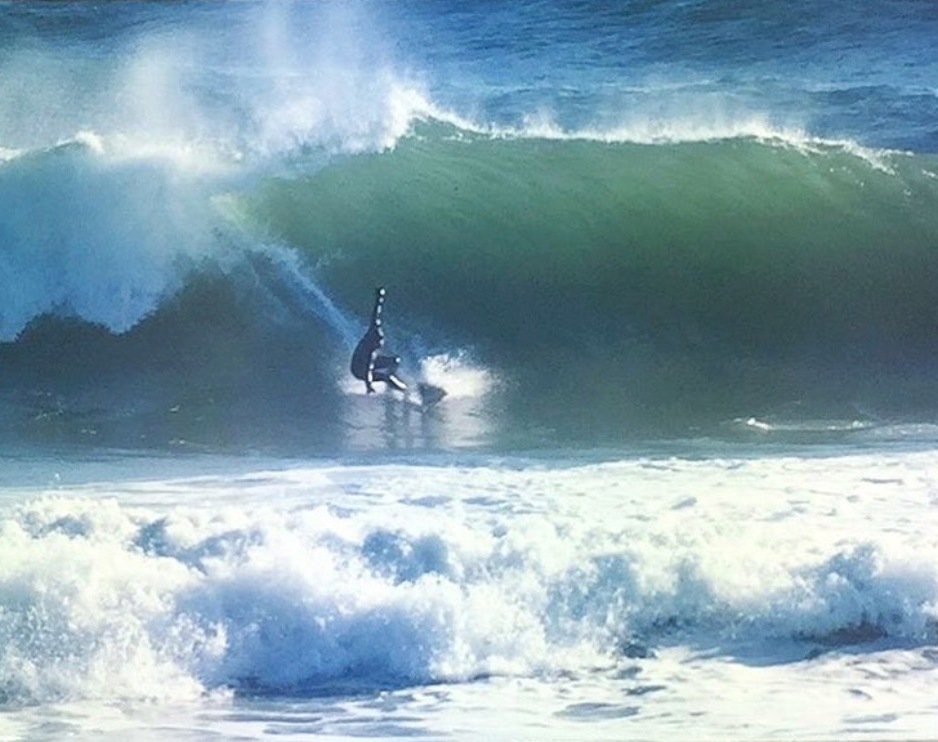
Maia: Alright so we were talking, Ruth was not here but we were talking about the time around your diagnosis and how you handled work and your insights about… Would you be willing to share any of that?
Ruth: So, you were diagnosed, you went in for some other reason you thought maybe pinched shoulder nerve that was affecting your snowboarding yeah and so you were diagnosed pretty quickly with ALS but you didn’t feel certain yet that that was a correct diagnosis so you didn’t want to tell anyone including me. But you definitely didn’t want to tell anyone at work. You wanted to just keep going until that was confirmed.
Michael:…
Ruth: Work is a big part of a man’s ego. You were afraid to give up the thing that you felt like…you were successful at. Right it took you a while to come to terms with the thought of not working so you continued working for two years without telling anyone at that work that you had ALS. In hindsight that’s the only thing you regret around that time is not not letting go of work sooner because you are you were working for the wrong reasons.
Michael: When I gave my notice we went right to Costa Rica.
Ruth: When you gave your notice. We went right to Costa Rica after that. {and you never went back]. And you never went back to work, you gave notice, yeah it’s a small town you saw people afterward and, yeah that was very… people were great, people were really supportive and that’s all good but I think that was probably a good way for you to do it rather than give notice and stay there and have to go through a lot of emotional goodbyes. It was easier to, you know, make that break, go away on a nice surf vacation and then come back and deal with the aftermath, yeah in a better place.
That was the trip after you left work though that’s true when you couldn’t surf just standing in the waves, the waves are so big that they were knocking you over. That was super hard, yeah.
Maia: Yeah, I mentioned to you when we were talking earlier is that out I’ve had to certain mysterious one of the reasons is as I told you before I told Michael undiagnosed situation, health challenge that I’ve been dealing with the last two years which has at times affected my ability to surf and I have been unable to surf really in the way that I have developed a taste for. And it’s, it’s been a really interesting transition of acceptance and embracing the mystery of it and not knowing what tomorrow is going to bring in and realizing that at some tomorrow every surfer will be done surfing. This is the nature of life and surfing is the best part of life and it really, it has been, well it’s been maddening and very sad at points for me to think about not being able to surf for you know a week or a month or however long it’s been. I’ve also found it really helpful to have had those, the lessons that surfing has taught me. Has that been true for you since not being able to surf?
Ruth: Surfing’s all about adapting to the situation. So being able to adapt and keep going forward. I mean, that’s what ALS is all about too. I mean, it’s all about adapting, and adapting.
Michael: muffled…
Ruth: [Laugh] I say that I can remember you saying early on that when you couldn’t surf any more was when you would be ready to let go and you don’t remember saying that and clearly, that hasn’t come to pass. But there were a lot of conversations, you know, soon after an ALS diagnosis about you know, you’re going to be going through this all of this, all of these, these losses, losses of abilities and losses of things that you used to enjoy so much.
And so we saw this film “Consider the Conversation” and it really is about end of life choices and there was this really just moving part about this person who had this notion of a list of 100 things, you write 100 things, you think of 100 things that you love and that you enjoy and as you age or have a debilitating disease you lose the ability to have or do those things and for each person the point at which your life is no longer meaningful, the number will be different, you know, like for somebody it might be if they can’t do 20 things on that list the rest of them aren’t enough to make life worthwhile, or that’s what you think at that point but for somebody else if they still have 1 thing on that list that they can still do they might want to stay alive. And so we were having those kind of conversations about what would the things on anybody list be? Which things would be at the top of the list? When would you really feel like life is no longer worth living? Is it when you can’t walk? When you can’t talk? When you can’t sing? When you cant eat by yourself? When you can’t surf, and I think that’s what I remember it was around the time the conversation about that movie and you were like, “Ugh, if I couldn’t surf, like I don’t know, I don’t know if I want to live and now we’re 5 or 6 years out from that and you no longer surf but you certainly, you’re living.
So you found that your list does have a lot of things on it besides surfing that you still want to live for. Cause I wonder if back at the time like before you lost the ability to surf you may have been imagining that, “Well, when I can’t surf, I can’t do this, I can’t do this, like I won’t be able to do so many things but it wasn’t that way. Surfing is a highly skilled endeavor, right, so when you lost the ability to surf you really could still do a lot of other things I mean you really started getting into the motorcycle after that. So but back then when you were thinking, “Oh, if I can’t surf I might not want to live.” you weren’t really envisioning all the other things that you still could do and also just the whole life of life with other people.
Michael:…
Ruth: That is a good point. Thank you honey?
Maia: What did he say?
Ruth: He told me that is a good point. Laugh
Michael:…
Ruth: Yeah, so you realized you had a passion for surfing but really surfing’s just part of your life and you’re realizing that you actually had a passion for life, surfing was just a part of that passion for life. And you still have that.
Michael: I still consider myself a surfer.
Ruth: You still consider yourself a surfer. Even though he’s not surfing he feels like he’s still a surfer because you’re still so in tune with the surf and the conditions. And many other things that surfing teaches are still a part of your life today.
Michael: Relevant
Ruth: Relevant to your life today as we are talking about before the patience, resilience bravery…
Ruth: He just had this interesting little observation the other day that I had never considered, he was saying that so, um with ALS when you lose muscle that includes tongue and throat and so swallowing can be a challenge and aspiration, choking can be a danger. So he does aspirate and choke a little bit sometimes and this is just such a strange connection he said that he feels like he’s able to get through that because of skills he learned from surfing when you get pounded and knocked under and your rolling around having to hold your breath underwater and stay calm and you know find your way through it and find your way up. That that skillset is what he uses to stay calm when he needs to clear his throat and he’s literally not breathing for a little bit because there’s an obstruction but he is able to maintain calm and not freak out because he learned that from doing it surfing.
Michael: muffled …
Ruth: Hold on, don’t panic.
Don’t hurry the moment
Ruth: Don’t hurry the moment it will pass.
Keep your calm so you’ll be there when it passes.
Michael: muffled …
Ruth: Keep your bearings. So, persistence, persistence obviously is a part of surfing you’re saying now with ALS and how it’s affected you, you have to be persistent just in your walking, just staying on your feet you have to be persistent and aware.
Michael: Determined
Ruth: Determined
Ruth: In surfing you have to be determined to get out through the waves.
Michael: Now… muffled … not let ALS rule my life.
Ruth: So now it’s the determination to not let ALS rule your life.
Michael: Right.
Ruth: I think balance too. I mean this isn’t a lesson like a cognitive lesson but it’a a body lesson that all the time spent on the surfboard, it’s so much about balance and the same with snowboarding, right? The balance and I wonder if, all of that time doing those sports where you’re getting off balance but you recover your balance— that’s what it’s all about because the medical people are amazed that you’re still on your feet. So I think it gave you some really great balance.
Maia: You were a pretty good surfer?
Michael: I think so
Ruth: He thinks so. In his own humble opinion. [LAUGH]
Maia: Very interesting. And Ruth you never wanted to surf? Did you try it?
Ruth: I never really tried much I mean I paddled around on a board and I didn’t have the persistence for it in Maine. I swim in the water in Maine but to be in the cold water in Maine also doing something really hard, I just, it didn’t call to me.
Maia: It didn’t sound fun.
Maia: As Micheal said earlier, motorcycling was his adaptation— the way he found to nurture his passion for life by setting out on adventures that challenge and inspire him. I asked Michael and Ruth to tell me a little more about Michael’s motivation for taking long trips on his bike to remote places like Novia Scotia and Hudson Bay where there’s no one would be around to help if he ran into trouble.
Ruth: He always wanted to do this motorcycle trip because you have to be independent and self sufficient, these backroads, you have to have fuel with you you have to have all your gear and your out in the middle of friggin nowhere all by yourself laugh. You wanted, he wanted to do it before he could not, I mean time is ticking, you know, with your physical abilities so…
Back then you were thinking that you might be dying in the hospital within a year or so, so you wanted to really get out there and challenge yourself physically before you did. Yeah So that’s why, was that you question about why he took that adventure?
Maia: Absolutely. Did that happen after you’d stopped surfing?
Michael: muffled …
Ruth: So he did, I think 3 really long, big, remote ones like that and then which might have overlapped with the time that you had to get done surfing because you took some falls on the motorcycle. So when he began falling on the motorcycle because he didn’t have the strength in his legs— when you come to a stop you gotta put your leg down— then he decided he wanted to continue motorcycling so his adaptation was to get a side car. And he still has, so when you got the motorcycle with sidecar you took trips with that too and one notable one when you got your BMW you went from here all the way across country by yourself to Arizona and back.
Maia: Wow!
Ruth: LAUGH Yeah, motorcycling was a passion for him too. And that continues so his motorcycle with sidecar is in a barn just down the road and he’s hoping to get it out any day now and see whether that’s still going to be a possibility this summer.
Maia: So I want to back up just a minute to when you were talking about how you still consider yourself a surfer. It sounded like what you were saying is you can be at the water and look at the waves and you still have a surfer’s relationship with them. You can still engage with them in that same way. And this is one of the ideas that has emerged over time as I’ve been doing these interviews and thinking more about Waves to Wisdom, is that on some level it is fundamentally a question about relationship and the practices that enhance certain kinds of relationships. And I think most of us, not just in this culture, but as humans we, in all relationships we really tend to get a little clingy and desperate and scared all the time. And I think that that in some ways, at least in this moment for me, one of the most inspiring parts of your story is that this fundamental part of your identity endures beyond anything that you can or can’t do with your body because it’s about your relationship with this thing, the ocean and all the things that it’s taught you. Is that a fair characterization?
Michael:… Absolutely
Ruth: Absolutely
Maia: Is here anything that you can think of that you’d like to add to that that I might have missed.
Ruth: To him it doesn’t feel like it’s been 5 years since he surfed. It’s in his mind, it’s in his heart, he still has a deep relationship with the ocean.
Intellectually you know that you cannot surf…
Michael: In my bones I feel like I’m still surfing.
Ruth: But in your bones you feel like you’re still surfing. That you don’t have to still be surfing to have a relationship and a connection to the ocean? Yeah. It’s like a lot of things that you have. For any body, for any human as you get older there are things that you did or you had that you can no longer do or have but they’re not erased entirely from your being. It’s still there, it’s still part of you, whether it’s the memories of it, the physical memory of it, or the things that you learned and took from it.
Maia: How long did it take you to get good? How long did it take until you felt you were good, I should ask?
Ruth: He probably felt like he was good right away. That’s his personality [laugh].
Maia: Is there anything else you would like to tell people about surfing, life, waves, anything?
Michael: I had a good partner.
Ruth: You had a good partner. Yeah, I think anybody in a good relationship with someone else, when that person has a passion, you support that passion.
Maia: Probably came back in a better mood than he left?
Ruth: Yeah! Definitely. And we all got to go on a lot of great beach trips.
Maia: Thank you both so much.
A lot of great beach trips could sound like a bunch of vacations, fun but fleeting. But Michael’s story seems to me a powerful demonstration of the theme I’ve found in my own life of outdoor pursuits and, more recently this dedication to an ocean-centered practice. Ours is a culture that values wellness and scientific research that supports it, sometimes to our peril. Everyone my age will remember the low fat orthodoxy of our youth and the processed, packaged fat-free foods that stocked the shelves of many of our pantries. There is plenty of new scientific research showing the benefits of activities in natural settings and I’ll post about some of that in the coming weeks. But Michael’s story is more persuasive to me that any research.
A passion for life that takes the form of devotion to a kind of fluid, fully embodied activity like surfing offers so many potential gifts of joy and wisdom, none of which are necessarily dependent on that ultimately undependable life circumstance, physical health.
For more information about coaching, our ocean-centered retreats, or to inquire about sponsoring this podcast, visit wavestowisdom.com
Playtime: Part 1
The changing circumstances of a dynamic, shifting environment of moving water and gathering or diminishing light… these periods of peak change are always an exercise in healing my frayed American relationship to time. Time is, after all, both the one material on which all my other endeavors, hopes, wishes, and lessons depend for their existence and the medium in which they are rendered.
A few nights ago, I walked the short jungle path from my shack in Playa Guiones, Costa Rica to photograph in the day’s last light on the crescent shaped, white sand beach. As the scene grew redder by the passing minute and sinking sun, I watched a boy, dangling in the air facing the incoming breakers, held up by his strong young father’s hands. As each line of whitewater reached them the man swung the child into the wave in a dense cascade of spray, kicking, and laughter.
Last night, during a different sunset shoot, I saw two young girls scramble up a 5-foot rock wall from a clear tide pool. Atop what must have felt to them like a precipice, they reached for each other’s hands, then jumped. Crescendos of laughter lent cadence and rhythm to both their fall and landing. They plopped down and dug into the sand to scoop wet hands full. Flinging sprays and globs of sandy muck onto the rock wall and each other before bouncing up, they commenced a new cycle of climbing, jumping, flinging, laughing.
This morning, during sunrise, I rode faster, steeper waves than I would have dared when I first arrived here in Costa Rica a couple of months ago. Working hard to choose fun over fear, I paddled over the edge of one particularly large wave and, as I felt my feet find the board, I heard a hoot of encouragement from a young, male Costa Rican surf instructor. When kind of exchange happens I often feel a comforting happiness swelling the thrill of the ride from a deep, primal place, as though I’ve achieved some kind of tribal inclusion. Although unaware of the passing minutes, I spend a lot of time smiling out in the sun and have a world class wrinkle tan to prove it. I have surfed every day my energy allowed and for every second I dared to. No one had to suggest it was a good idea, nor did it take any will-power. I do wear a watch, a chronometer, to keep myself accountable to physical limits adrenaline and just so much fun might tempt me to ignore.
It is easy to be “disciplined” about “exercise” and put up with the adversity in the line-up (the occasional pummeling by whitewater, the risk of a crowd with many beginners, the exhausting nature of the endeavor) when there is the hovering promise— but never a guarantee— of sheer, unadulterated joy. As a matter of fact, the difficulties and occasional fright I feel surfing lend dimension to the bliss and turn it into a sacred, instructive kind of play. Perhaps the same is true for the swinging toddler and the jumping young girls? One thing’s for sure, none of us is counting the minutes.
The changing circumstances of a dynamic, shifting environment of moving water and gathering or diminishing light as the sun crests the mountains or sinks into the sea— these periods of peak change are always an exercise in healing my frayed American relationship to time. Time is, after all, both the one material on which all my other endeavors, hopes, wishes, and lessons depend for their existence and the medium in which they are rendered.
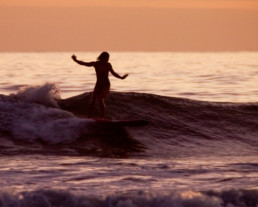
Looking around at the people on this beach, each in their way being playful, it seems we can feel time in our own bodies. We can know the reality of ephemeral happenings lived as we evolved to live them, immersed and fascinated by the world we inhabit and our unlikely existence as its sentient manifestations.
Sunsets and rises are a part of the day when the unidirectional arrow of time feels particularly speedy. Looking around on the beach with waxing or waning light, the planetary movement that gives our days their time renders each elapsing moment of life visible. Somehow this acute awareness of life-time passing never feels stressful and is often inspiring. I wonder if this is true because, at that beautiful hour, the lived experience between blindingly bright and blindingly dark is fleeting and so packed with visible change? It’s a kind of vision that allows us to lose track of the chronological minutes and feel time in the form of moving bodies of sun and earth, light and shadow, deepening or diminishing darkness. Looking around at the people on this beach, each in their way being playful, it seems we can feel time in our own bodies. We can know the reality of ephemeral happenings lived as we evolved to live them, immersed and fascinated by the world we inhabit and our unlikely existence as its sentient manifestations.
Something I’ve learned from watching the people I’ve guided into similarly playful, awe inspiring, sometimes challenging experiences is this: so often they lose track of what we usually think of as time. They emerge into some other deeper awareness of life’s steady, simultaneously cumulative and erasing movement. Each experience takes its rightful place as both a new moment lived and a time forever passed. It’s a way of sensing the contradictory nuance of how brief and full our life time is, or can be, if we cultivate our capacity to show up for it. We love economic metaphors so perhaps we could become more full, authentic participants in our time if we move from spending time to paying attention. This kind of attentive, body-grounded presence and the time perception it allows is a passage, like in music or literature, that moves you towards a concentrated capacity to sense life and the light that illuminates it. Then it becomes a passage, like a journey to another realm of feeling and, with practice, of knowing. I find this sort of ontological clarity and orientation, a creaturely comfort in physically being in one’s time, is most often within easy reach on the beaches I gravitate towards to play and work during these transitions into and out of the well-lighted world my diurnal eyeballs evolved to navigate.
And, at least here in Playa Guiones, I’m not alone. Sunsets in this coastal village are community playtime. People come out at this time of day to talk, to splash, meditate, dig, toddle, and crawl. Some of us come to surf or just to watch this display of time’s movement and be inspired and energized by it. At those moments, time is not our enemy.
I’ve come to believe that, if I am, if we are to have a fighting hope of healing our relationship to our own time, we need more words for the it, this stuff of our lives. The Greeks had at least two: chronos and kairos. Chronos is time as we generally think of it— the kind that can be counted and measured— seconds, minutes, hours, days, and years. Kairos is the sort of time we mean when we say the time is opportune or propitious, a moment (extended or fleeting) in which something must necessarily happen for it to happen at all. A deeper, qualitative kind of time, kairos evokes the layered, unknowable sequence of events and circumstances that must come together to make a time “right.”
I’m writing a draft of this post on a floppy, sandy journal balanced on one knee on this Pacific beach where harried foreigners and locals gather together daily to recover from stress, to lose track of chronos, to find their kairos, and to do so through play. In his interview with Krista Tippett, philosopher and poet John O’Donohue said that “philosophically, stress is a perverted relationship to time, so that rather than being a subject of your own time, you have become its target and victim, and time has become routine.” There is a genius to this sometimes achingly beautiful place. In it’s original, Classical Roman use, the word genius was part of a longer phrase, “genius loci,” meaning the protective spirit of a place. So many of us are here to hope Nosara’s genius will help us heal form emotional or physical challenges. Playtime is central to the potential healing, to rediscovery and renewed protection of some forgotten joy and wonder-filled place deep in each of use. We return because we forget and we need to be reminded of how to rehabilitate our sense of time and return home with new perspective. But what do you do if you can’t (or just don’t want to) run off to a tropical beach?
See Playtime Part 2.
Play Time: Part 2
Brown makes a case for the benefits of disrupting American culture’s frequent, knee-jerk suspicion of anyone whose life seems especially playful, of dismissing anyone who appears to be having too much fun.
We are evolutionarily engineered to need life-long play in order for our brains to continue to grow and develop in the ways that keep us happy and healthy.
Brown says “the opposite of play isn’t work.” It’s depression.
Interested in how you can make your life and brain better (and have fun in the process)?
After studying more than 6,000 humans, Dr. Stuart Brown has a simple answer to enhancing your life and time right where you’re living them— whoever you are, whatever you do––, play more. In Play: How It Shapes the Brain, Opens the Imagination, and Invigorates the Soul Brown explains some of the contemporary research that points in the direction of increased playfulness as the pathway out of a range of challenges more diverse than those that bring people to Nosara. According to Brown, there isn’t much we should take more seriously than our fundamental, biological need for internally motivated, unstructured play. It’s a need that powerful cultural currents pull us away from honoring. Brown’s book is a call to action, asking us to, please, for your own sake, be counter-cultural. And beyond the level of basic self care, play is a route to flourishing and enhancing your mental and physical health, creativity, and cognitive functioning. More creative, healthier, smarter people sounds like a recipe for positive societal change, not just self improvement.
So what is play?
According to Brown, play, while difficult to define absolutely is not a subset of activities but a state of mind.
If you’re playing:
You feel what you are doing is voluntary
You’re undertaking an activity for its own sake because it’s inherently attractive, not because it’s useful
You have diminished consciousness of self
You feel the activity has improvisational potential
You want to keep doing whatever is making you feel so darn playful
You experience freedom from time
In that last characteristic of play (which is also definitional to the concept of flow) I’m reasonably certain Brown means the chronos kind of time. He wants you to take inventory— when was the last time you lost yourself in the unbridled joy of deep play? If it’s been too long for you and, especially, for your children, you’re courting trouble. Brown’s extensive research includes studying a range of folks, from the happiest and most successful (Nobel laureates) to the violent and sociopathic, (mass murderers). Brown’s take on the sociopaths? Not surprisingly, most of them had a history of abuse but he also found a crucial absence from the histories of the most violent males. No matter who they were or where they were from, they didn’t play enough.
Brown makes a case for the benefits of disrupting American culture’s frequent, knee-jerk suspicion of anyone whose life seems especially playful, of dismissing anyone who appears to be having too much fun. Adults who play a lot risk being perceived as wasting time in unproductive, frivolous, probably selfish undertakings. I’ve witnessed (and suffered from) this cultural tendency plenty! As someone whose vocational life and professional calling has often looked like the sort of “useless” activities most people do as amateurs, for fun and love, I’ve winced under the disapproval (perceived or real) of other adults as I pursued photography, backcountry exploration, and surfing as if they were my job until, at last and somehow, each, in turn, actually was part of my job. Now, looking from the vantage point of middle age, I know that if my play impulse hadn’t been so undeniable, I would have bowed to pressure. If I’d had any real choice I would have spared myself the shame and angst of not fitting in and chosen something more grown-up, more lucrative, a more appropriate use of my time.
As I read Play, I’ve never felt more grateful for the lack of impulse control that kept me outdoors, learning, moving, and trying to get others to come along for the rides. To have bent to the pressure to achieve something that looked more normal and serious and important, to have denied these fundamental enthusiasms, to have used instead of living my time, that would have been an egregious denial of something at least approximating the sacred. It would have meant rejecting the most abundant gift I’ve received in life— an occasional, often unpredictable, always fragile opportunity to help other people connect or reconnect with the meaning, joy and potentially playful depth of life that’s on offer to most of us, regardless of adversity, each day we are fortunate enough to be breathing as the sun moves across the sky.
Brown notes that while the state of being he labels play requires engagement in a “useless” activity,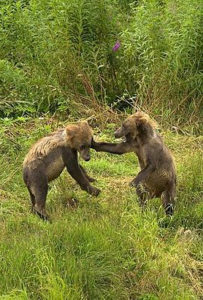 play itself is not only useful but primally so. The very uselessness of the activity itself must mean that the state of mind is somehow crucial for us mammals, or it would have been weeded out by evolution long ago. He introduces husband-wife research team Johanna and Robert Fagan who studied play in grizzly bears. The Fagans found that the individuals who played the most were the most effective at surviving.
play itself is not only useful but primally so. The very uselessness of the activity itself must mean that the state of mind is somehow crucial for us mammals, or it would have been weeded out by evolution long ago. He introduces husband-wife research team Johanna and Robert Fagan who studied play in grizzly bears. The Fagans found that the individuals who played the most were the most effective at surviving.
Why would play lead to a better chance of survival? It has everything to do with that organ in your skull. Neuroscientists Sergio Pellis and Andrew Iwaniuk and biologist John Nelson figured out that there’s a link between relative brain size and playfulness. They looked at the brains of 15 species and found that species with larger brains (relative to their body size) played more. Even more intriguing, John Byers has carefully studied several species— while more research is needed, Byers believes play allows mammals’ brains to make sense of and “sculpt” themselves.
For me, and perhaps other readers with a feminist bent, one of the most provocative parts of Brown’s book and argument is his rendition of the well-known Marian Daimond research on rats growing up in an ‘enriched’ environment. What made for an enriched environment? Toys and companions, in other words, play. Diamond figured out that the rats who played the most developed bigger, better (more complex) brains. “’The combination of toys and friends was established early on as vital to qualifying the environment as ‘enriched…’” So why did Diamond call these rats enriched instead of playful? “‘Back in the early 1960s, women had to struggle to be taken seriously as scientists,’ Diamond said. ‘I was already seen as this silly woman who watched rats play, so I did avoid the words ‘toys’ and ‘play.’“
Brown says, far from being silly, whether we are talking about young or old mammals (including the human kind) “The truth is that play seems to be one of the most advanced methods nature has invented to allow a complex brain to create itself.” In a misogynistic culture, it doesn’t take a big logical leap to move from the denigration of children spending time playing with the women whose days most often pass in overseeing and engaging in this child’s play to the denigration of grown-ups spending (wasting) time doing anything that resembles those women and children, outwardly or emotionally.
Think the kids whose parents can afford one high dollar league or lesson after another have an advantage? Not according to Brown. It turns out that, in denigrating play, especially the unstructured kind, we might have been setting ourselves up for underdeveloped, less creative and effective adult brains, both cognitively and socially.
Why is unstructured play important? The need to make up and sort out “rules’ appears to be a necessary ingredient for helping us develop a sound moral foundation and key capacities like impulse control. The purported lack of unstructured play in many youngsters’ lives does not bode well for their future functioning.
I think about my own play history. By all measures, I was and am a person with a wicked case of ADHD but it never quite got in my way. Which means, despite being able to check off almost all of the symptoms, “disorder” is a misnomer. I experience myself as requiring a different, more frenetic, variable, and physically focused sort of order and I somehow managed to come up with work-arounds and avoid pissing off all the grown-ups.
Now, I grew up solidly middle class with a single-mother who earned a decent family income. I had enormous privilege as a child. No doubt my mother’s Rousseauian, let-the-kid-be-who-she-is attitude helped with self acceptance. But I’m convinced it was the application of her parenting attitude combined with the freedom to run and roam alone and with friends, sometimes traipsing miles through the woods near my suburban home as we honored our urges to learn and imagine and move together. That was probably what saved me. The skills I accidentally developed helped me understand how to escape ostracism and trouble by coming up with ways to accommodate most of the important rules and my own uncontrollable impulses towards movement, challenge, action, stimulation, and adventure. Brown doesn’t touch on income, access, and racial differences, and I know full well how fortunate I was to have those woods behind my tract house in the suburbs. But, if Brown is right, regardless of other challenges, less adult-supervised soccer and more pick-up games or fort building and imaginative play time in safe parks and patches of woods with no grown-ups anywhere might be good for us as individuals and for society as a whole. Access to places for children to move their bodies together, to explore, discover, and lose track of time in unstructured play starts to look like a basic human right.
Maybe you’re convinced that play is good for developing children’s brains but still feel suspicious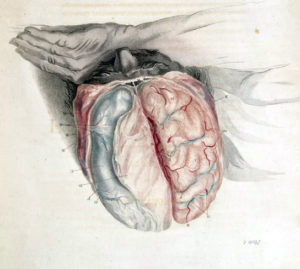 of playful adults? After all, our adult time is valuable (read remunerated) in ways children’s can’t be. Brown lays out the facts of our brains. Unlike many mammals, we have an exceptional capacity for brain development and neurogenesis (making new neurons) over the whole of our lifetime. While children definitely have a need for more playtime than adults, we are, according to him, evolutionarily engineered to need life-long play in order for our brains to continue to grow and develop in the ways that keep us happy and healthy. He says “the opposite of play isn’t work.” It’s depression.
of playful adults? After all, our adult time is valuable (read remunerated) in ways children’s can’t be. Brown lays out the facts of our brains. Unlike many mammals, we have an exceptional capacity for brain development and neurogenesis (making new neurons) over the whole of our lifetime. While children definitely have a need for more playtime than adults, we are, according to him, evolutionarily engineered to need life-long play in order for our brains to continue to grow and develop in the ways that keep us happy and healthy. He says “the opposite of play isn’t work.” It’s depression.
He argues that finding play-states at or during work makes us better workers and that play is, in fact, “essential” to doing the highest quality work. He recounts the play histories he took of two Nobel laureates, neuroscientists Roger Guillermin and polio researcher Jonas Salk. Brown writes ”I realized that what they were doing every day in the laboratory was playing. When Roger took me through his laboratory he was like a kid as he described his experiments… Their play was esoteric and difficult to understand for most people, but activity and the joy were the same as they would be for a kid in a sandbox.”
And then Brown drops what I found to be a beautiful prompt for anyone feeling stuck in finding or deciding on a new direction for their work life. “The work that we find most fulfilling is almost always a recreation and extension of youthful play.”
I can hear the protests now (because I’ve heard them so often, many times in practiced, full-throated, choral unity as my inner demons opened up to unleash a new wave of self doubt). Play is fine for some people but most of us have to settle down to the grim business of boring adult reality. And, let’s face it, the houses, roads, and office buildings, the passive entertainment and scales of efficiency and all of the other infrastructure we’ve built have not been designed to maximize our capacity for play, for utter delightful absorption in and satisfaction with the present moment. In many cases, they’ve been designed, intentionally or not, with effects that are quite the contrary. Much of our built environment maximizes our capacity for wanting more which, in our boxed-in longing, we often interpret as a wish to purchase more amenities for the cages that limit our creative vision and movement in the first place. The amenities we pay for in money (abstracted life time) rarely change our longing in any enduring way and the cycle of working to not meet our needs continues as the days come and go and we remain, in John O’Donohue’s words (see Play Time part 1), victims of time. Brown takes a shot at understanding where some people get stuck and where some of the angry resistance to prescriptions of play come from. “When some unhappy people hear the message about the importance of play,” he writes “they get angry and defensive, realizing what they’ve missed.”
He’s careful to point out that you don’t have to quit your job or become a Nobel laureate. Even just occasional play might help get you reacquainted with the feeling and could, with practice, become habit-forming. So how do you cultivate a state of play? If Brown is right, play can happen under many circumstances and according to individual preference but there are some that are particularly conducive.
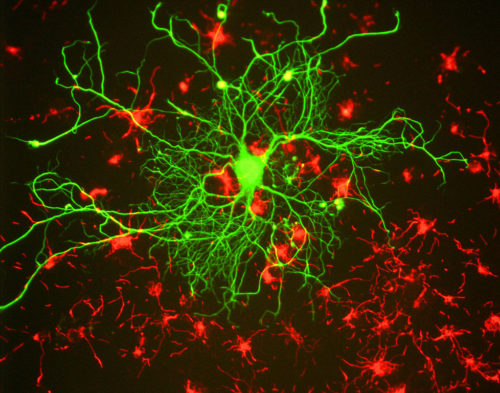
Moving your body in playful ways (dancing, racquetball, drumming or dancing with gusto) “lights up the brain and fosters learning, innovation, flexibility, adaptability, and resilience. These central aspects of human nature require movement to be fully realized. This is why, when someone is having a hard time getting into a play state, I have them do something that involves movement: because body play is universal. As Bob Fagan says, ‘Movement fills an empty heart.’”
One of the impulses that led me to undertake the Waves to Wisdom project is a deep intuitive 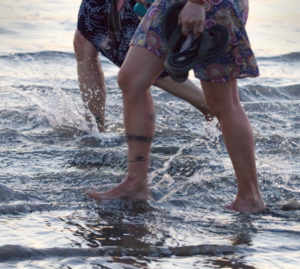 knowledge, developed through years of experience, that combining some intention and guidance with what Brown calls “movement play,” particularly when it takes place in or near the water, has the potential to deepen the meaning people perceive in their lives and to rehabilitate our relationship to our own time. Play can allow us to rediscover that each day has the potential to be filled with kairos, not just paced off in chronos.
knowledge, developed through years of experience, that combining some intention and guidance with what Brown calls “movement play,” particularly when it takes place in or near the water, has the potential to deepen the meaning people perceive in their lives and to rehabilitate our relationship to our own time. Play can allow us to rediscover that each day has the potential to be filled with kairos, not just paced off in chronos.
For so many of us, the combination of reflection, a few challenging existential questions to ponder, some low-stakes creative undertakings, and ocean play can prompt new metaphors that synchronize previously competing urges, reveal inspiring juxtapositions and connections between seemingly separate facets of our one life. Immersion, literal and figurative, in this sort of play can change previously petrified, self-limiting beliefs about what is possible. Play in a higher power (like the ocean) offers embodied experience and guiding metaphors that render those limiting beliefs fluid or dissolves them entirely. Sometimes people come out of these experiences with a dramatically new idea for their lives or work. More often they find layers of potential for meaning and joy, for really living their day and night times. They see and articulate meaning and purpose that have coursed through their lives all along, unnoticed or unappreciated. Brown sketches out what our brains have to gain. While there’s no guaranteeing precisely what each person who plays deeply will come away with, we know what they have to go in with, an internal motivation.
He writes, “Authentic play comes from deep down inside us. It’s not formed or motivated solely by others. Real play interacts with and involves the outside world, but it fundamentally expresses the needs and desires of the player. It emerges from the imaginative forces within. That’s part of the adaptive power of play; with a pinch of pleasure, it integrates our deep physiological, emotional, and cognitive capacities. And quite without knowing it, we grow. We harmonize the influences within us. Where we may have felt pulled in one direction by the heart and another direction by the head, play can allow us to find a balanced course or a third way.”
I understand. It isn’t easy.
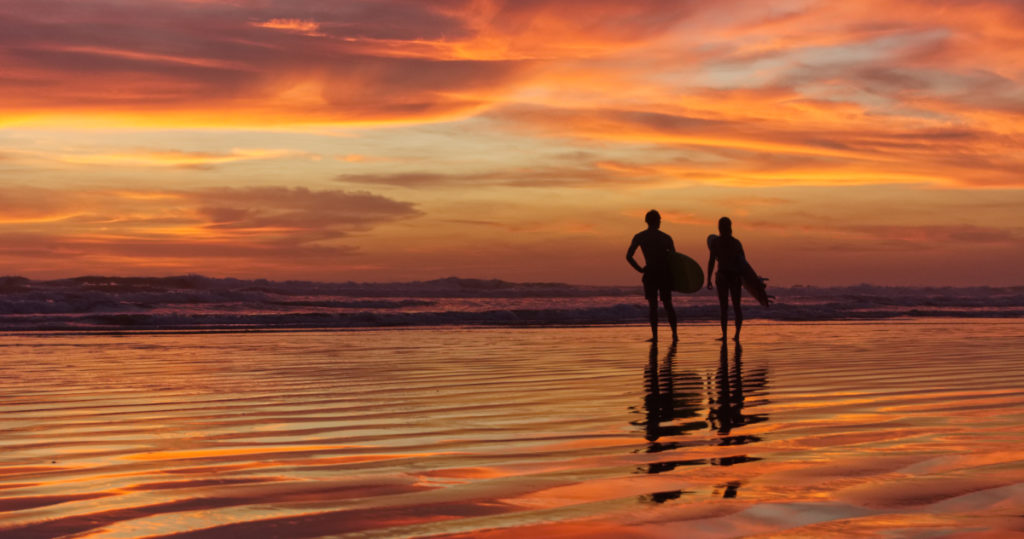
One of the reasons I and so many others spend a chunk of our chronos here, in this jungle village where I’m writing the final draft on a dusty keyboard as sweat drips from me in the dead of North American winter, is the kairotic potential of this tropical place. Take those sunsets. Most of us are, wait for it, out there without our phones. Now, you still see plenty of humans curved down over their gadgets but, just as often, those who did bring phones are looking up, necks arched to hold heads high, to take in something beyond the screen. Often those screens are then lowered, the photographer giving way to the subject, surrendering neither to the bound, segregated sensory world of the phone camera’s view, nor to the seconds and minutes that too often tell us whether it is time to eat, to rest, to love. I see it every day that I take my own camera out there, the other photo snappers putting the phone down for awhile and letting their awareness move with the planetary rhythm of time, of changing light. I see them lose track of it all and let their senses come alive in connected response to the shifting of what’s beyond. You can almost see the barriers dissolve— we lose a little of the lonely existence of individuals and join with Others out there, human and aquatic, biological and geological, planetary and cosmological. Sometimes they (and I) photograph out of that feeling or try a new maneuver on our surfboards that, if we pull it off, will send an arc of spray up in the lovely light, or we swing our children into the water or bring them to tide pools to give them the richest life imaginable. And then sometimes we just stand there and feel it, alive in our own bodies and their time, letting all of our senses and our unfolding history flow into our vision. And if we do make a beautiful photograph, or execute a new maneuver on a surfboard, or elicit unbridled laughter from our child in the midst of that moment, well, as far as I’m concerned that is at the heart of what art at it’s best is all about anyway.
The belly of the high cirrus cloud bank that descends from just above the setting sun down to the point at the north end of this Pacific bay has just started to go pink. All day I’ve watched the clouds in the sky, rare in this season. I’ve hoped some would remain as I measured the day’s events by the coming time for me to I bring the camera down for immersion in the warm evening light-bath. The sun has receded behind the ocean now and a pink stroke of cirrus in the sky saturates as the light is bent by the atmosphere, only allowing the longer, redder, warmer wavelengths through, making them take their time to get to us and our eyes, now all pointed in one direction on this beach. A rippled, ascending cloud is reflected in the wet sand, now exposed by the receding tide, the closest thing the ocean might have to a second hand. The horizon between these pink diagonals now forms the shaft of an arrow pointed towards what my eyes perceive as gathering obscurity in the darkening east. The light during and after sunset often brings me to some emotional shore where tears wash onto giddy laughter and, judging by what I see around me on the beach, I’m not the only one moved by the spectacle, not the only one whose time has been touched. When the last point of the orange sun disappeared below the line of the distant ocean, people applauded.
In Memoriam, Mary Oliver
Mary Oliver made a sacred practice of her direct sensory experiences, her intimate bodily connection to her place and days. And then she did the hard work of crafting some altered but analogous version of those experiences, rendered through lines on a page. She made us feel what she sensed. Then, at least for her dedicated students, she inspired us to go out and be passionately sensory in our own bodies, to make sense of the world for ourselves.
This morning I carried my surfboard across the sand towards the water as the sun came up on the other side of the hill behind me. It’s one of an arc of foothills ringing this white-sand Costa Rican beach set deep in the jungle. As I walked, I looked out to one of my dear friends, L, already in the water. I am often aware of the difference between us. She’s significantly younger and, at this point, stronger than I am. She’s German and speaks English, thereby allowing our friendship. I’m American and (despite a LOT of Spanish DuoLingo) still just speak English. She’s one of the few people I know who loves to share waves with friends as much as I do. I treasure every session we have together. The walk to surf is always thrilling and often at least a little bit scary. Heading out to ride waves with loved ones adds a primal tribal thrill to the experience. We are here. Today, the instant the first wave ran over my feet, the sun crested the mountain and L was suddenly bathed in intense warm light. Now there were two of her, one whole, embodied version and another, equally clear and colorful liquified reflection undulating, spreading, and shrinking in chaotic lyrical patterns on the water beneath her. I remained in shadow of the mountain as I walked deeper into the water. For a few delicious seconds, with someone I love out there, in another world but deeply connected, her fleeting moment in light and mine in shadow helped me sense something about life and death, about love and age and loss and, above all, about beauty.
John O’ Donohue said that in the presence of beauty we feel more alive. Beauty, he said, is quickening, not deadening. If he was right (and I believe he was), then Mary Oliver was among the truly beautiful humans of my era. I suspect I might have said that was true before last week, but the collective pain and celebration of her death lent texture to that truth. She made so many of us feel more alive. She wielded what looks to me like a powerful sort of magic. She made a sacred practice of her direct sensory experiences, her intimate bodily connection to her place and days. And then she did the hard work of crafting some altered but analogous version of those experiences, rendered through lines on a page. She made us feel what she sensed. Then, at least for her dedicated students, she inspired us to go out and be passionately sensory in our own bodies, to make sense of the world for ourselves.
She communicated her amazement, her knowledge of how to pay attention, through plain language, alchemically transformed into powerful incantations that conjured a world fully populated by sensuous others, this grasshopper and those wild geese, a hungry bear and swollen blackberries. Each seemed to enter our brains in numinous phrases that, in turn, filled our bodies with something so potent that those lines could shift a day. With enough reads, they could shift a life. An intensely private person, she worked in a way that built a community broader and deeper than I’d known before last week. Her power turned the understandable, hopeless, endless streams of social media outrage at the outrageous into a moment of collective pain with beauty, not vitriol and fear, at its center. Despite a difficult childhood, her work never, not once, indulged in self-pity.
I don’t believe the thought ever occurred to me, that Mary Oliver was going to someday die. This week, the week she left us, I’ve been thinking about little else. There is Upstream, which I devoured and revisited like a brilliant, new, love-at-first sight friend. And those last books and poems, many of which I’ve not yet read— she might have died before having gotten to those. So, in addition to an unexpectedly profound grief, I am swimming in gratitude for her. I clearly failed to recognize my own attachment to her as a living being. I began writing this, the week she sensed her last day, surprised to find myself falling into grief. After all, most of the writers I love are dead. I never met Mary Oliver. She almost never gave interviews and I knew almost nothing about her life except that she made a habit of walking early with paper and pen, courageously built a life with the women she loved, taught college writers for awhile, and had an almost eerie capacity to write what I most needed to read. I only heard her for the first time a few years ago, when she released a cd of readings, called On Blackwater Pond. By then her voice was that of a much older woman than almost all publicly available photographs of her, except the often reprinted portrait of her as a youngster, the one taken by her partner of decades Molly Malone Cook. The few Mary’s I’d seen, young, suddenly middle-aged, then old, punctuated the fact that her life had occurred somewhere hidden. Meanwhile her sometimes denigrated work poured out into the public that I felt fortunate to be a part of. I didn’t know her and still have just as much of her as I ever did. I have her lines on a page. And yet, here I am, grief-stricken.
A few days after she left us, there was a total lunar eclipse— a Blood Moon. I watched the eclipse near midnight, lying with L and many strangers on a dark, windy beach in the northwest of Costa Rica. Like Oliver’s death, the eclipse was a surprisingly emotional experience. I have seen several but they never fail to move me. Despite thinking I’m ready, I always go in unprepared, and come out surprised. Last week I lay on that beach, pelted by fine grain sand working its way into every orifice, looking up through the binoculars provided by a well-prepared German I’d never met and couldn’t recognize now (“Fernglass, anyone?”)
I watched as the eclipse turned “total.” The moon was red with the thinnest leftover losenge of reflected white daylight on its left side, like an opening parenthesis promising a useful aside. I lay there open, in a way I’ve long practiced, ready to sense and learn something. I owe that sort of receptivity in large part to Mary Oliver. And learn I did. I could, in that instant, finally feel why each eclipse is so affecting and maybe Oliver’s death too- similarity across scale.
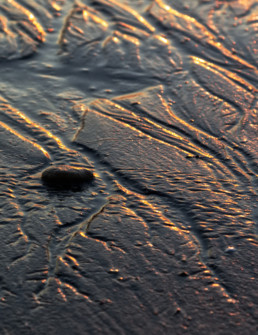
Fractals are … are nearly everywhere you look in nature and even in those organs doing the looking (the wild, spherical landscape of your eyeball). Coastlines and clouds are fractals and so are trees and your circulatory system. A tree is a fractal because the trunk, branches and leaf veins continually repeat the pattern of dividing into smaller and smaller, self-similar shapes. Your circulatory system is also a fractal. Your aorta is fat then branches off repeatedly into thinner and thinner vessels as the recursive pattern (and nourishment it allows) reach towards the edges of your body.
There’s a shape in mathematics (stay with me here!) called a “fractal.” We all know many fractals, and have known them for far longer than there has been an English word or any math attached to them.
The fractal foundation defines fractals as
infinitely complex patterns that are self-similar across different scales. They are created by repeating a simple process over and over… Driven by recursion, fractals are images of dynamic systems – the pictures of Chaos.*
Fractals are complicated (even chaotic) patterns arising from simple, repeating processes. They are nearly everywhere you look in nature and even in those organs doing the looking (the wild, spherical landscape of your eyeball). Coastlines and clouds are fractals and so are trees and your circulatory system. A tree is a fractal because the trunk, branches and leaf veins continually repeat the pattern of dividing into smaller and smaller, self-similar shapes. Your circulatory system is also a fractal. Your aorta is fat then branches off repeatedly into thinner and thinner vessels as the recursive pattern (and nourishment it allows) reach towards the edges of your body.
I only learned what fractals were after becoming obsessed with them as a photographic subject. I knew that that recursive shape was beautiful, that it looked like life. It made perfect sense when I finally learned a little about the geometry. And it didn’t just do so in the intellectual way but as David Abram says, things that make sense enliven the senses. That night, for one of the first times in my life, watching that eclipse, I could feel the math. I could sense similarity across a vast difference in scale. My pounding heart joined the percussive chorus of pelting sand and the distant mathematical music of those spheres (sun and moon) working with the earth, supporting me as it put on this show. It was revelatory that the earth, a body larger than my own tiny mind can imagine, was moving through light and casting a shadow just like my body does. I could see it happening. In that moment it was hard to not feel like a part of the whole, a small, sensing section of the cosmos with just as much right to cast a shadow as the earth itself, just as much freedom to be carried by wind as the sand. With my heart opened by sadness and quickened by beauty it was possible to feel like, in my own humble way, perhaps on scale difference about on par with the difference between my body and the earth’s, I have been making my own kind of Oliverian beauty. I have been living “one wild and precious life” spent as “a bridegroom taking the world into my arms.” Mary Oliver had, in her work, given me permission and guidance to take the million steps that got me to that beach, looking through a generous stranger’s fernglass. Because of Mary Oliver, I felt free. After a lot of doubt and many wrestling matches with shame, I felt free to accept that this precise sort of experience as the foundation of my work in the world. Rooting intellectual and spiritual learning in the sensuous world is at the root of the most powerful form of service I can offer others.
But in the years before I knew her poetry, it sure didn’t feel that way. By any measure, as a child and adolescent I would have been diagnosed with attention deficit disorder (had it been available, or my mother capable of entertaining for a fleeting moment that there might be anything disordered (as opposed to extraordinary) about me. Equally intolerant of disapproval, sitting, or being told what to do, I spent my early adulthood mostly going through the motions of my formal education. When freed from that, I wandered around what I was pretty sure were enchanted woods near my North Carolina home, splashing through creeks that felt like friends. When I got a little older, I added taking pictures to the journeys, so that even when I was in I could relive the reverie of being out.
I taught myself the technical aspects of film and darkroom photography through a series of three books Ansel Adams wrote. I spent time every single day staring at reproductions much more lavish than anything I could then make in the darkroom. I devoured biographies of the great modernist photographers I admired, Imogen Cunningham, Edward and Brett Weston, Ruth Bernhard, and Tina Modotti. Their stories of visible achievements earned by their own traipsing with cameras, slaving over prints and, most of all, finding teachers, guides, sometimes one another to help them develop their skills and vision, infected me with a ravenous hunger for a mentor who might help me figure out my confusing life. I spent years searching feverishly for a guide, an older person who was out there doing what most people I knew probably characterized as wasting time, exploring the natural world without an agenda of expertise. And then, later, crafting beauty. I wanted a guide who spent her life staring, trying to really see already beloved places, to know them fully in some carnal, intimate way. That, after all, was how I’ve lived most of my life as a photographer. I was pretty sure everyone I knew must be judging me harshly for it. The self torture was senseless— I was too young to know no one really cared what the hell I was doing with my time.
And I really didn’t have any choice about how I went about that work anyway. Only after I felt the flower, the creek, the rock, the wave had somehow entered me, that the subject had allowed me some sort of communion, only then did I feel it was polite to get the camera out and make something I could take away and show others. Although all that seemed like a childish habit to hide, to be ashamed of, in my early 20s, I knew I had no choice but to be out there doing just that. If I’d not been afflicted by a bad case of needing to be a good girl, I might have rebelled outright but I was looking for a work-around and permission from someone in authority. I was entitled enough to feel like I should be able to be unconventional with approval. I wanted an elder human whose life looked at least remotely livable who I could ask the hardest questions and who might give me some indication that they understood and cared what the hell I was talking about, that it all mattered, that I was okay and just needed to keep working. I never found that person in the flesh and spent too much time feeling either terrified or sorry for myself for about a decade.
Then, somewhere along the way, I was given a copy of New and Selected Poems by Mary Oliver. It came out in 1992, right about the time I became a full-time professional photographer. I’d been an English major and had read plenty of poems, plenty of nature writing. I had (and still have) a dogeared Walden that I carried around with me nearly everywhere. But I had never been schooled by another human like I was in the time I’ve spent with Mary Oliver. She taught me that the precise sort of hyper-focus on what was most mesmerizing and the desire to fall passionately in love with the most minute parts of place (specimens, some might call them) was not a disorder, or didn’t have to be. It could be the foundation of making, or entering something beautiful. Her arresting, deceptively simple writing made me see that if you worked on making something out of what you learned in the heat of the passion that characterized those experiences, you could create a life that could be quickening, not deadening. And, if you found ways to repeat the tiny, sacred patterns on larger scale as you went, perhaps the beauty you made would not just be for you but for someone else, maybe even several someones else.
In short, Mary Oliver helped me get over myself and focus on creating meaning out of the magic of being alive. Over the next few years living with her lines as part of my days, I came to understand what has become one of the guiding principles of my own life. Inspiration is sacred and, metaphorically, a calling. The power of the planet as a whole and of the human-scale habitat we occupy, the gravity and fluids and fractals that give our beleaguered, paved-over, cut down world and our own bodies their multiplicitous shapes, that power deserves our focus. And, regardless of the source of your inspiration, if you can find ways to translate your focus, your joy, and love into a substantial offering, if you can somehow recognize your gifts, whatever those happen to be, and augment them with skills so that you can someday serve someone else’s need for meaningful focus, for nourishing attention, for meaning, and beauty then you might even be better than okay.
Why hadn’t the other naturalists and nature writers I’d read, especially Henry David Thoreau, done that for me? That question has lodged in my head since Oliver’s death and I think the answer might be especially relevant to our current political, cultural, and environmental moment. Intellectually, his sort of dedicated observation seemed superficially similar to what I was

unconsciously cultivating as I tried to figure out how to be by walking through rivers and developing film, but it felt almost opposed. Thoreau, it seemed to me, was making an argument that wilderness was the solution to a human problem. I was not looking for wildness, which suggested some sort of insurmountable gulf of difference between me, a discontented product of civilization, and every other thing out in those woods. I was looking for (and finding) intimacy, connection and belonging, a means of ending, once and for all, a lonely isolation behind some barrier I just couldn’t shake no matter how good or easy or privileged my life was. I needed a dissolution instead of a solution.
There’s one line from Walden that I think might get at the heart of the difference between these two writers and, in turn, the difference between one way of many of us unthinkingly approach our lives and one another. Thoreau often wrote with a voice that emphasized his expertise and assuredness, and he had plenty of both! When he evoked the animal, sensing part of him, it was often in opposition to his humanity.
“I found in myself, and still find, an instinct toward a higher, or as it is named spiritual life, and another toward a rank and savage one, and I reverence them both. I love the wild not less than the good.”
Thoreau’s writing promised transcendence and a superior way to live, as opposed to all the poor saps in bigger houses with day jobs. Wilderness could save you. Don’t get me wrong, I loved what he wrote and even spent five years in a cabin in the woods with no bathroom, living out my own version of Walden.
But, in retrospect, I believe that the desire to achieve some kind of transcendence (and implicit superiority over all this business of every day life) and the agony of the certain knowledge that I was so flawed, so prone to inattention, and likely to fail at being an expert grown-up didn’t help me one bit. I knew enough to know that I didn’t just need abstract knowledge, that studying anything in disembodied form wouldn’t stop the fear or bring the connection. I grew up in a place where waiters were likely to about to have (if they didn’t already have) PhDs. I saw experts everywhere, but so few people living a life that looked all the way alive.
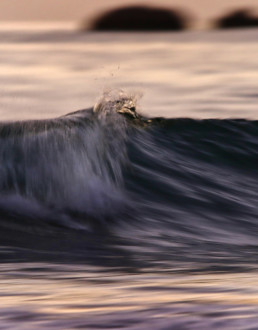
But Oliver wrote with such humility and a passionate, intimate continuity between what she was and what she sensed in the other. In poem after poem, she defied all my expectations about books and writing. She was never the world’s superior, often its supplicant. Just to pick one of many examples, in Luna, she wrote of her encounter with a moth, an individual possessing and fulfilling its purpose during a few short days and she felt no need to neatly order and classify it, to identify it as one of many Actias luna.
Of herself in this meeting with the moth she wrote
I live
in the open mindedness
of not knowing enough
about anything.
Seeing the moth dead “hurt her heart,… another small thing/ that doesn’t know much.”
And while Thoreau boasted about his life well-lived, time, for Oliver, often seemed scant. There was no amount of life in the woods that would save the lover from the grief of losing the beloved too soon.
Even the summer “also has its purposes/ and only so many precious hours.”
She saw value in grasshoppers, not just as specimens in a system (genus/species) like Thoreau had. Instead she was concerned with this grasshopper, the one she could touch, the one who also looked right back at her, with its own agency and the vision of “enormous and complicated eyes.”
In retrospect, that book of poetry I stumbled on in the 1990s turned Oliver into the mentor I was looking for. Her writing helped me dissolve that barrier I’d carried around since I was a teenager. As a result, I got a lot less lonely and self-absorbed and a lot more generous and receptive. With her help, wild and good became indistinguishable.
Later, when I unexpectedly fell passionately in love with teaching and I found myself playing the very role I’d never found anyone to fulfill for me, I realize the gift Oliver had given me was magnitudes of order greater than I’d thought. As desperate as I’d felt to find someone I could trust to tell me I was okay, I discovered the reason to find a mentor is not so you can be okay. That’s only a fraction of the story, one vein in the recursive pattern. Mentors allow you to develop the wherewithal to guide others, to show them that they are, in and of themselves, as okay as any mortal can be. That they can let the soft animal of their bodies love, that their life is, in fact precious, and that being idle and blessed (at least as Oliver clearly was) isn’t as easy as it sounds but that no thing is more worthwhile, especially if you can build from those moments some form of service or calling. As you help others find their place in the pattern, you create your own.
This month saw the death of a beautiful mentor, a guide, another human who loved and looked hard, who labored and lost and grieved and then transfigured all of that life into writing that reached so many of us. As dependent as I am on walking into and feeling water, on seeing light and shadow, on learning directly through my sensual existence, I can’t imagine the last 25 years without those poems. They helped me recognize that the deep attention demanded by love, in any form, of a friend, a partner, a moth, a wave, work, or play, is the most abundant, generous, exacting, and profound teacher we can learn from. I could repeat her lines like incantations, those patterns of observation, of passionate receptivity, and offer them to so many others who, in turn, could feel they were, flawed though they might be, a part of “the family of things.” LINK Over and over, the aortic abundance of Mary Oliver’s work gave me a pattern I could adapt and repeat. It lent dignity to the tiny branch of beauty I was working to create. She offered her life in service of the most disciplined, lovingly crafted version of her intimate moments and, in turn, offered me my own. Grief does seem the only human, the only beautiful response. As much as my thinking homo sapiens brain knows better, this was a month when it felt like the moon and earth, the sand and the shadows and the surf, all bowed their heads to acknowledge the loss.
If you’re interested in setting up a free, no-obligation conversation with Maia about coaching, mentoring, or a custom retreat, email her at maia@wavestowisdom.com.
- Check out Ron Eglash’s fascinating TED talk about fractals at the heart of African designs
Winter Solstice
December 21, 2018Philosophy,Nature
Choice, acceptance, and caretaking in the dark
Every life includes moments when there’s a fundamental shift, something beyond our control and, potentially, our capacity to comprehend. Sometimes these shifts are brought about by a dramatic event: a birth, death, or diagnosis, something that we can’t help but have enough sense to notice, attend to, try to remember and learn from. Sometimes these alterations in our world, and in how we are in it, bring with them a series of clear choices. But, for those of us who live a life of sufficient food, water, shelter, and lots and lots of screens, these potential shifts can often start as subtle, seemingly minute changes, as subtle as a day that’s a couple of minutes shorter, then one that’s longer. Changes like these are easily overlooked in the sensory onslaught of our culture with its pop-up plagued, quantum acceleration of the superficial masquerading as the meaningful.
Many of us, myself definitely included, have to struggle (if we think to struggle) to hold on to a connection to a sensory world that’s not altered by our immediate choices. We have to cultivate a daily feeling of full embodiment, of being alive, loving, hurting, laughing, grieving social primates in an enchanting web of life that somehow, improbably, landed us here, in a place. Perhaps we encounter mystery and resilience in a squirrel in the backyard who is managing life with no tail, or some cocktail of magic and revelation in an unexpected encounter with a stranger who might become the friend we’ve always longed to share our thoughts with. Or maybe we hear about a new book that, if we make time to read it, might exponentially deepen our appreciation of the nuanced mystery in what we thought we already valued and knew. Perhaps, one otherwise quotidian, scrolling, swiping day, we might allow ourselves a chance to fully inhabit spacious time and try something unfamiliar that could become a practice that, if embraced with discipline, will change our vision of the possible and reacquaint us with what’s important.
Many of us, myself definitely included, have to struggle (if we think to struggle) to hold on to a connection to a sensory world that’s not altered by our immediate choices. We have to cultivate a daily feeling of full embodiment, of being alive, loving, hurting, laughing, grieving social primates in an enchanting web of life that somehow, improbably, landed us here, in a place.
Whether through opportunity, exigency, or emergency our own life moments can, by their nature, be difficult to predict in particular but, once we’ve lived enough blind-siding loss and unearned joy, we know they’ll continue to come to us. But then there are other changes that encompass all of our lives, as reliable as the seasons. If we can muster it, full attention to changes that emanate from a world we perceive as beyond us are instances of potential transformation for us too. This attention is hard-won. Sometimes even these most predictable of shifts in the more than human world (like the solstice) are so subtle that we can miss or dismiss their whispered offers.
Perhaps our default thinking is hyper critical and we’re skeptical of mystery. Or our focus is fragmented by the empty promise of fleeting stimulation that blinds us with an illusion of control with scant spiritual or existential satisfaction— too many consumer “choices” that, when exercised, just leave us feeling drained (emotionally and financially) and still hungry for more. We sometimes have to work to reinforce or resuscitate our intuition, our deep animal sense of recognizing moments of profound choice in the face of the why-is-there-something-not-nothing mystery. It takes intention to bring that intuition to deciding which option might be good for us. This capacity benefits from practice at reflection, internal quiet, and the courage to ride whatever waves that quiet throws at us. It usually means eschewing many opportunities in favor of one single, sometimes elusive one. It could mean honoring whatever unpredictable thing needs to happen, first internally and then, with still more courage, in honestly realizing the shape our unfolding life must now take.
Cultivating this kind receptivity can take so many forms. Seated meditation is powerful and, although it took me half a century to finally do it with any regularity, has since proven an invaluable addition to my own life. But sitting on my cushion in my living room is still putting myself in a very comfortable, pleasant box and my sliver of the culture, especially this time of year, is definitely both comfort and box-heavy. For me, being in the surf, especially in small waves where I have little (but not no) fear of an entity that is clearly, undeniably, and perpetually beyond my control is one of the most potent ways I’ve found to train myself to have the open minded and open hearted awareness to be alert to potential of all sorts. Balancing a view of the constant horizon line and the changing pattern of swell in the water, I can work on my bodily recognition of shifting possibilities in every evanescent instance. Recognizing my own fluctuating limitations and capacities and matching those to the ongoing opportunities of oceanic flux is a way of cultivating what I most value in myself (appreciation, enthusiasm, a gift for pattern recognition, and a capacity for unbridled joy) and what I really freaking wish I had more of (careful attention, courage, independence).
Living at least part of life according to the dictates of tide, weather, and wind offers a watery grounding that makes many of the surfers I know happier people. They are scientists, professors, real estate agents, engineers, artists, tradespeople, and dozens of other things when they are dry. But when we’re in the water we all become something different and similar, separate from our land-lives but connected to one another, supplicants of the sea. We cheer our friend into waves as we feel the thrill of the other in our own tingling bodies. In precious seconds of profound connection we are re-created by feeding off of energy moving them, both wave and body visible manifestations of invisible planetary forces. While oceanographers and good old-fashioned Newtonian physicists could explain plenty of what’s going on out there, the immediate sensory experience and the knowledge that none of us can control those forces lead us to a common interior place— mystery.
But, of course, it isn’t necessary to surf a wave to get this kind of grounding and cultivate this kind of practice, to encounter mystery and profound companionship in the more than human world. As the wise and eloquent surfer Andrea Kabwasa pointed out, any intimate, ongoing, disciplined connection to the natural world has the potential to get you there. And, for better or worse, in our structured, boxed-in, screenful world, it does take discipline for most of us to find and maintain this sort of connection. Kabwasa points out a straightforward path open to most of us. One that leads to spending more time turning things off, going outdoors, and being in what’s there, in your place.
It’s December now. It’s the time of year, at least here in my mid-Atlantic, Northern Hemisphere latitude, when the butter tastes better and the sun disappears too soon. It’s easy to find yourself (by which I mean myself) wishing for more daylight and warmth. And, if you’re fortunate enough to have some choice over where you spend your time, it can be exhilarating and energizing to escape the cold and dark and travel somewhere warm and sunny… But even if the darkness is all you can access today, that very lack of control might just offer you some wisdom— all the more so precisely because you have fewer choices.
In her book The Nature Fix, Florence Williams summarizes the current research showing how good for us getting out in the natural world is, even if we aren’t always comfortable while we’re out there. Long before Williams penned this informative read, I’d witnessed so many people experience the transformative power of stepping away from the climate controlled box where all the lumens you needed to see under and behind every hidden place were a flick away. In the process of figuring out how to be okay in the cold darkness, of watching light fade and letting their senses adjust, people often confront and, after some internal drama, transcend a kind of fear they hadn’t previously had cause to even suspect they were limited by. I’ve witnessed this fear enough times, in myself and others, to recognize it as a sacred opportunity, although I’ll never lose the wincing empathy I have for those going through it for the first time.
Taking some old, tried ideas into the darkness with you can help your mind know what to do with the fear. I recently read Sharon Lebell’s The Art of Living: The Classical Manual on Virtue, Happiness, and Effectiveness. 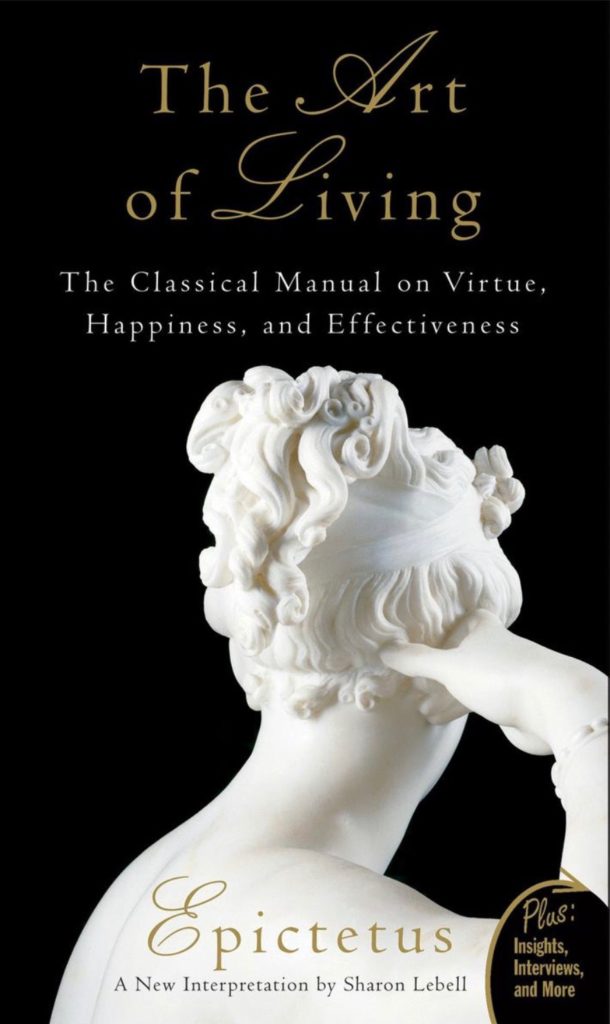 It’s a slim, entirely accessible contemporary translation and interpretation of the practical philosophy of Epictetus, a Stoic philosopher who lived from about 55 to 135 C.E. He thought that learning and living philosophy (literally, the love of ideas) is a practice that is both available to and good for everyone. The opening lines of this book are:
It’s a slim, entirely accessible contemporary translation and interpretation of the practical philosophy of Epictetus, a Stoic philosopher who lived from about 55 to 135 C.E. He thought that learning and living philosophy (literally, the love of ideas) is a practice that is both available to and good for everyone. The opening lines of this book are:
“Happiness and Freedom begin with a clear understanding of one principle: Some things are within our control and some things are not. It is only after you have faced up to this fundamental rule and learned to distinguish between what you can and can’t control that inner tranquility and outer effectiveness become possible.”
Right after discerning the un/controllable, one of Epictesus’s central tenets is that living well and moral development are synonymous. In our time and culture we tend to think that elites of all sorts (athletes, celebrities, professional artists, mega-Insta-influencers, and bazillionaires) have some kind of a corner on the living well market because they appear to have endless control and choices. Even the most sophisticated, critically minded of us can feel we aren’t quite somebody until we have evidence we’re successes, a book, a scalable idea, profitable business, or a large following. But going out in this moment of darkness can remind us of who we all are and what choice can really mean to us. Epictetus writes from a time when almost everyone had little control over their destiny. His philosophy of recognizing what you must relinquish to find peace offers a remarkably refreshing approach and, for me at least, a potential prescription. There is one passage that seemed especially relevant to this moment in our collective lives.
Caretake this moment.
Immerse yourself in its particulars.
Respond to this person, this challenge, this deed.
Quit the evasions.
Stop giving yourself needless trouble.
It is time to really live; to fully inhabit the situation you happen to be in now.
You are not some disinterested bystander.
…
He goes on
When your doors are shut and your room is dark you are not alone.
The will of nature is within you as your natural genius is within.
Listen to its importunings.
Follow its directives.
As concerns the art of living, the material is your own life.
No great thing is created suddenly.
There must be time.
Give your best and always be kind.
~Epictetus (Labell)
It is a season particularly prone to distractions from what I think Epictetus might mean by “the natural genius within.” We are in the cold dark season of the year and, it seems, in one of the cold dark (and decidedly unkind) times in our communities and country. It’s easy, in this moment of amphetaminic advertising and constant (mostly dire) news coverage, added to the holiday pressure to party, to dwell in dissatisfaction with the choices, leadership, historical moment, budgets, experiences, and even companions we actually have and to bemoan our lack of control. This dissatisfaction is no accident. Our social media feeds are full of people surfing better waves, dangling from steeper cliffs, having perfect weddings/better vacations/smarter children/etc./etc. Cutting-edge neuroscience is employed by hawkers to figure out how to get our brain’s reward center (the ventral striatum) to move us to want more of the choking assortment of available stuff, and the best possible experiences, plus more money, more recognition, and, while we’re at it, more of something crucial but elusive that we can’t quite identify but sure would like to just purchase in bulk from Costco.
All this apparent choice (and its illusion of control) can overwhelm. In the late 1980s the late, great David Foster Wallace wrote an essay about the effect on his cohort of the expanded assortment of television channels that came with cable.
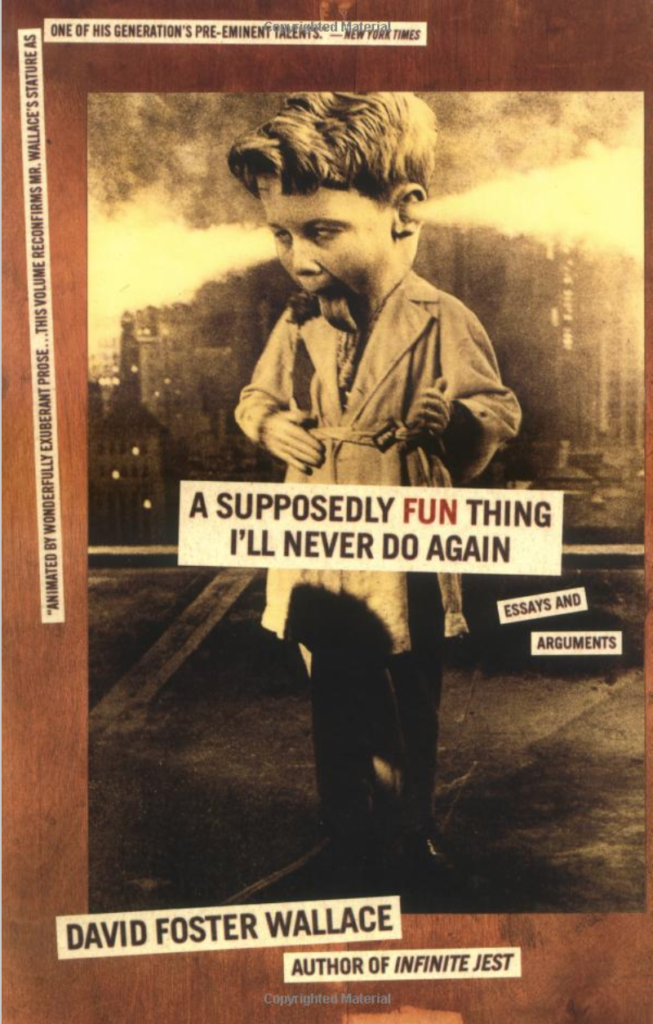
While it can seem almost medieval to think about only 40 channels of possible incoming distraction (as opposed to the 210,000,000 Google just delivered in response to me entering the word “distraction”), or the endless feed of my social media, I think he was onto something fundamental about the problem with a glut of choices.
Wallace wrote
“contemporary [entertainment] has gotten vastly better at enabling the viewer’s fantasy that he can transcend the limits of individual human experience… As a Treat, my escape from the limits of human experience is neat. As a steady diet, though, it can’t help but render my own reality less attractive (because I’m just one Dave, with limits and restrictions all over the place), render me less fit to make the most of it (because I spend all my time pretending I’m not in it), and render me more dependent on the device that affords escape from just what my escapism makes unpleasant.”
We really do get only “one wild and precious life.“
Plus these damn gadgets (like the one I’m typing on, the very one that gives me access to some damned inspiring photographs, eloquent writing and NPR, Mrs. Maisel and Encounters at the End of the World, and, and, and) are a source of light and, like moths, we sure do seem to like light. But long light isn’t this moment. Not in this place. It’s tempting to watch, and scroll, click and read our way through this dark season but, if Wallace was right, our escapism is what fuels much of the unpleasantness we have to work so hard and spend so much time and treasure to escape.
These short days and long nights of the cold, dark time offer their own unique abundance of wisdom and lessons if we can convince ourselves to layer up and go into that darkness where we are not really alone. If we can lean into and deal with the material out of which our lives are woven right now, and hold tight the hand of the friend who’s close, we might be able to see something in the dark we could never perceive in the light. The solstice is a fundamental shift beyond our control, one that we all have access to. If we can make our bodies more deeply aware of the days’ hours and feel that shift, if we can allow ourselves a regular dose of quiet in the dark, I have little doubt we could develop our capacity to hear the sotto voce opportunities for greater meaning, connection and caretaking in every moment.
Once you let your eyes adjust, it turns out the darkness isn’t only that— it’s also a resetting of your senses to perceive and find revelation through quieter light.
Here’s wishing you all a meaningful, mysterious, and adventurous Winter Solstice!
Further Exploration:
If you prefer to engage with Epictetus in a less interpreted form (a worthwhile endeavor!), you can read his discourses online for free here:
http://classics.mit.edu/Epictetus/discourses.html
While I have not sampled them all, I’d stake resources on a bet that David Foster Wallace delivered the single greatest commencement speech in the history of the genre.
An NBC listicle offering 5 good reasons to go out in the cold:
https://www.nbcnews.com/better/health/5-good-reasons-go-outside-even-when-it-s-freezing-ncna843331
“Physiological and psychological effects of walking on young males in urban parks in winter” Chorong Song, Dawou Joung, Harumi Ikei, Miho Igarashi, Mariko Aga, Bum-Jin Park, Masayuki Miwa, Michiko Takagaki and Yoshifumi Miyazaki. Journal of Physiological Anthropology (JSPA)201332:18
https://jphysiolanthropol.biomedcentral.com/articles/10.1186/1880-6805-32-18#Sec3
Too little time? Too many things?
November 13, 2018Saltwater and Mental HealthFloatation therapy
Try a float tank to explore an interior landscape with a saltwater fix, even if you’re city-bound, landlocked, and only have an hour.
Do you miss the saltwater?
Even for those who live at the coast, our daily lives and the time pressures we all accept as part of responsible adult life so often keep us from the places that rejuvenate and inspire us. Somewhere along the way, we assented to a push of priorities that prevent us from getting the daily (or even weekly) dose of mystery and beauty that can render the routine sacred and turn boring repetition into disciplined discovery. When just a few minutes’ time creek or seaside could make all the difference there are weeks when we feel like we can’t (or won’t) find that time.
In his interview with the inimitable Krista Tippett the late, great philosopher and poet John O’Donohue said
I’d say seven out of every ten people who turn up in a doctor’s surgery are suffering from something stress-related. Now there are big psychological tomes written on stress, but for me, philosophically, stress is a perverted relationship to time, so that rather than being a subject of your own time, you have become its target and victim, and time has become routine. So at the end of the day, you probably haven’t had a true moment for yourself to relax in and to just be.
Waves to Wisdom exists to guide people into a more creative, fulfilling, and abundant relationship with their time. The littoral zone is the sandy frontier where the land and we terrestrial creatures cede control to waves and water, the planet’s dominant element. The place is filled with both dynamic facts and transformative metaphors. When you’re there, standing on that edge or, even better, floating just beyond it, everywhere you look there are wordless poems writing themselves in their own meter and cadence. Water reflects and refracts light and, in the process, mixes colors, composes passages, spits out short, fleeting lyrics that, if you’re fully present and attentive, can swell your heart. And, if the visual and aural reveries weren’t enough, there’s the feel of the place– the ephemeral motion that, if you let your body succumb to its rhythm and internalize it, can change your mind, your day, and your life.
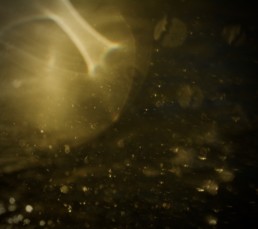
The littoral zone is the sandy frontier where the land and we terrestrial creatures cede control to waves and water, the planet’s dominant element. The place is filled with both dynamic facts and transformative metaphors.
But what if you don’t live near the ocean? All water is liquid and chaotic and rhythmic according to forces that, by their very complexity, are mysterious to our perceiving minds. Even dry landscape has its own movement and, although the timbre is subtler, it still offers portals into what O’Donohue calls a “true moment.” But what if you only have an hour in your busy week? Don’t work or live anywhere near a natural landscape?
You might want to spend an hour in a floatation tank. I just experienced my first float, after hearing Dr. Justin Feinstein, neuropsychologist and director of the Laureate Institute for Brain Research (LIBR), present at the annual Blue Mind Summit. The summit is a gathering of people from diverse professions and backgrounds who gather to share information and camaraderie about their work in support of the theory that being in, on, near, or under water is good for human health, mental and physical.
Feinstein summarized his paradigm-shifting research into the mental health benefits of Floatation Restricted Environmental Stimulation Therapy (REST), or spending time in a dark, shallow bath of warm water with so much Epsom salt in it you couldn’t sink if you tried. He is accumulating mounting evidence that Floatation REST works better than any known drug to combat anxiety and depression. He’s also convinced it can provide crucial help to people fighting anorexia and addiction.
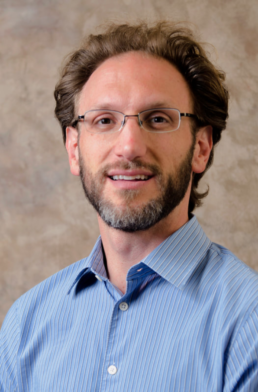
And it seems floating doesn’t just aid in just mental recovery. This straightforward, non-toxic practice with almost no unpleasant side-effects appears to aid recovery and relaxation after any sort of stress, including hard work-outs of your mind, body, or both. Powerful testimonials abound from people who beat eating disorders, Olympic athletes who recovered faster, even musicians who credited floating with enhancing their skills. I’d heard about float tanks for years but Feinstein’s talk left me resolved, once and for all, to get into one.
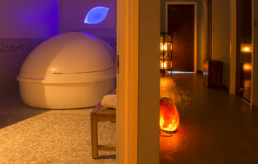
A week later I entered a TruRest floatation center through a nondescript door in a strip mall near my house. They call themselves a spa. The attendant ushered me down a hallway with dim lights and clean, neatly rolled towels on spare shelves.
I arrived at one of several private rooms, each with a shower and a smooth, white tank, lit within by rotating colored lights. The attendant walked me through the process, showed me the intercom button in case I needed help and offered a few options (tank door open or closed?, music on or off?, head resting on water or a little foam floaty?). Then she left me alone.
Squeaky clean, and earplugs inserted, I lowered into the 10-inch deep water with its 1000 pounds of dissolved Epsom salt. Some people suffer from claustrophobia so it’s not required to close the tank door but I wanted the full, womblike experience so I pulled the hatch closed, flipped the light switch and settled into the total, device-free sort of darkness we rarely experience. At my request, the soft music would stop after a few minutes and only begin again when my hour of floating was nearing its end. I tried a meditation technique I and many of my clients respond to right away, the full body scan. Just focusing on each part of your body in turn, feeling it in space, noticing it without judgment, then moving onto the next. In this warm water and the moist air, all calibrated to human temperature, it was difficult to tell where I ended and the world began. Instead of feeling lost, space and body somehow became one and, although my leg still felt like my leg, it and every other every part of me began to feel as though it encompassed a deep interior, larger, lighter, and more expansive than usual. My exploring mind had more room to maneuver inside my feet, then legs, then sacrum. With so much spaciousness and no external distractions, I soon felt a sensation I often have to work long and hard to achieve on the landward side of the littoral zone— a freedom from any desire to be anywhere else “better”, or to perceive something else more beautiful. It felt like my body and mind, even random thoughts that popped up here and there, they were all just me, not separated. Every thought and feeling was inextricably one, varied terrain in this small, dark sea– not good, not bad, just spacious.
It’s precisely this sort of moment of intimate connection between the body and the brain, and technologies to help bring this connection to the forefront of awareness, that is Feinstein’s and LIBR’s guiding principle. In that dark, buoyant place, experiencing as complete a sensory return to archetypal, maternal beginnings as I can imagine encountering with my adult body, the intimacy was undeniable.
I hadn’t felt like I was worried going into the tank but somewhere in the middle of the float, thoroughly relaxed in the darkness after less than an hour of this remarkable experience, as those random thoughts materialized and dissolved, I realized how much tension and busyness I’d been carrying in my mind and body. I had to work to recall the source of all that vague but profoundly felt concern. Less than one hour. Total relaxation. No pill could work any faster.
In fact, Feinstein’s most recent work focused on the effects of a single hour of Floatation-REST on people with severe depression and anxiety. Those effects were amazing! With almost no negative side effects (a few folks experienced mild itchiness or dry mouth) the article reported participants experienced significant reductions in anxiety, stress, muscle tension, pain, depression, and poor mood. As a matter of fact, “there was … a substantial improvement in mood characterized by increases in serenity, relaxation, happiness, positive affect, overall well-being, energy levels, and feeling refreshed, content and peaceful.”
These positive effects were more pronounced for the group with anxiety and depression than the healthy control group. In other words, the more they needed it, the more it helped.
These positive effects were more pronounced for the group with anxiety and depression than the healthy control group. In other words, the more they needed it, the more it helped.
Previous research showed that the positive takeaways of REST included lowering blood pressure and levels of the stress hormone cortisol. People also experienced increases in well-being, and performance. As if that weren’t enough encouragement to try floating, a 2014 study looked at the effects of floatation REST on a group of professionals participating in a company-sponsored wellness initiative. The results? “Stress, depression, anxiety, and worst pain were significantly decreased whereas optimism and sleep quality significantly increased.”
But how does it work? After all, I’m as Western in my outlook as anyone and I want to know the mechanism. What’s going on in that salty pool? In short, we don’t know yet. Feinstein’s questions focus on the neuroscience of fear, anxiety, and other negative emotions and mood disorders. He believes our bodies play a powerful role in all of our emotional states.
Scientists have learned that our brains are constantly receiving information about how various regions or systems in our bodies are doing, and then engaged in an unconscious cartography of mapping this information. Research in the last decade has shown that people from different cultures tend to locate the physical sensation of particular emotions in the same areas of the body. In other words, our body maps seem to be consistent across cultures and appear to be much more nature than nurture. Feinstein posits that disturbances in those maps might underlie many common mental disorders. If we can tune into our body maps by floating, apparently weightless, in silent darkness, we might be able to heal ourselves.
We have a culture that encourages a habitual tendency to ignore or denigrate the role of our bodies when we aren’t working out, or having sex, or some other explicitly physical activity. And when we do inhabit our bodies we so often do so with critical, editorial judgment rather than curiosity, gratitude, and a sense of exploration. This habit diminishes the quality of our lives, our work, and our contributions to our communities.
And when we do inhabit our bodies we so often do so with critical, editorial judgment rather than curiosity, gratitude, and a sense of exploration. This habit diminishes the quality of our lives, our work, and our contributions to our communities. If we can develop regular practices that allow us to increase our non-judgmental bodily awareness and, in turn, our awareness of the other bodies around us (including the more than human ones) we’ll all be more effective, creative leaders in our work and lives. With practice coming home to the reality that your body and mind are not actually separate, you can live a life more grounded in joy, play, and freedom and feel more like an honest, authentic version of yourself. And those better versions of us can do a much better job of managing ourselves, enhancing the quality of what we offer our various communities and, potentially, the habitats that support all of the above.
After all, one of the premises of Waves to Wisdom is that our bodies are a crucial but undervalued source of creativity, learning, and positive change. We have a culture that encourages a habitual tendency to ignore or denigrate the role of our bodies when we aren’t working out, or having sex, or some other explicitly physical activity.
But the mind-body split is as old as our culture and not easy to overcome. Inside the tank, I felt I’d somehow managed to do just that. Almost instantly, there was a disorienting, enveloping peace that allowed me to just notice random thoughts without chasing them or reacting emotionally. As the hour passed, I experimented with different arm positions and found the most comfortable one: elbows bent, hands above my head, as if surrendering. Life in the tank felt boundless, as if I were in a vast space akin to the beach or a mountainside, without any of the confinement I often feel in my car or even my living room. I was completely relaxed. Utterly supported with none of gravity’s reminders of mid-life joints. I could feel every part of my heartbeat’s rhythm. I lost any inkling of how much time was passing. Once I was surprised by what sounded like someone striking a small bell, a single, loud tone. Then I realized the sound was from a slight movement of my upper lip away from my front tooth. There was a kind of quiet in there I can’t remember ever experiencing and I could hear and feel things that are normally hidden in the din. This is precisely what Feinstein thinks is behind the dramatic results of his recent study of Floatation-REST therapy on people with severe anxiety and depression.
With practice coming home to the reality that your body and mind are not actually separate, you can live a life more grounded in joy, play, and freedom and feel more like an honest, authentic version of yourself. And those better versions of us can do a much better job of managing ourselves, enhancing the quality of what we offer our various communities and, potentially, the habitats that support all of the above.
When the music came on, I couldn’t believe an hour had passed. I climbed out of the tank and felt as though I’d just awoken from the best, longest sleep. After a long, hot shower to wash off the salt and linger in the feeling it left me with, I stopped at the front desk and signed up for regular monthly floats. The TruRest Spa I visited is one of many centers that offer a discount for regular attendance.
So many of us suffer from an inability to stop our habitual frenetic thoughts and motions, to slow down, deeply attend to what’s within, and learn from that attention. It’s no surprise that this is the case. All of our conveniences train us to stay shallow, go fast, and get to what’s next. As difficult as they are to come by in most of our days, periods of deep interiority have the capacity to allow us to sense our most engaged, freest selves. Somewhere in that lost familiarity with calm freedom of just being lie clues to what we might have to offer with different practices, ones that encouraged more depth in our noticing and fuller presence in our receiving. We can emerge from these moments with an understanding of our innate creativity, and how we might use it where we work and live. How we might serve more effectively, more wholly, and in ways that because they are true to who we are deep down in our bodies, energize rather than deplete us.
We can emerge from these moments with an understanding of our innate creativity, and how we might use it where we work and live. How we might serve more effectively, more wholly, and in ways that because they are true to who we are deep down in our bodies, energize rather than deplete us.
In the same interview I quoted above, O’Donohue said
“What amazes me about landscape — landscape recalls you into a mindful mode of stillness, solitude, and silence, where you can truly receive time.”
What I found in the tank was something resonant with the receptivity of an amazed mind as it dances in call and response with vast landscapes. It seems as though sometimes, if you really want to bring about more profound movement and change, to make a beautiful splash in the world, some buoyed stillness is the best place to begin. Even if you only have an hour.
To find a floatation center in your area or learn more about floatation therapy, visit this link: https://floatationlocations.com/
Sources:
“Examining the short-term anxiolytic and antidepressant effect of Floatation-REST” Justin S. Feinstein, Sahib S. Khalsa, Hung-wen Yeh, Colleen Wohlrab, W. Kyle Simmons, Murray B. Stein, Martin P. Paulus. Published: February 2, 2018
“Bodily maps of emotions” Lauri Nummenmaa, Enrico Glerean, Riitta Hari, and Jari K. Hietanen. PNAS January 14, 2014 111 (2) p 646-651.
“Eliciting the relaxation response with the help of flotation-rest (restricted environmental stimulation technique) in patients with stress-related ailments.” Bood, S. Å., Sundequist, U., Kjellgren, A., Norlander, T., Nordström, L., Nordenström, K., & Nordström, G. (2006). International Journal of Stress Management, 13(2), p 154-175.
“Floatation restricted environmental stimulation therapy (REST) as a stress-management tool: A meta-analysis” Dirk van Dierendonck, Jan Te Nijenhuis. p 405-412
“John O’Donohue: The Inner Landscape of Being” On Being with Krista Tippett
“The Acute Effects of Flotation Restricted Environmental Stimulation Technique on Recovery From Maximal Eccentric Exercise” Morgan, Paul M.; Salacinski, Amanda J.; Stults-Kolehmainen, Matthew A. Journal of Strength and Conditioning Research: December 2013 – Volume 27 – Issue 12 – p 3467–3474
Interview: Elsa Rivera
September 15, 2018Ocean as teacher,Podcast,Women in Surfing,Saltwater and Mental Health
To listen to the interview, scroll to the Player at the bottom of the page.
"... my whole neurological being, body, mind, and spirit, is enhanced when I get in the water. And when I come out my perception, my storytelling about any particular "problem" is, it's just redefined.
I don't sweat the small stuff."
~Elsa Rivera
Interview Transcript
Intro
Maia: My name is Maia Dery. This episode impart of a series called the Waves to Wisdom Interviews. The project is a simple one. I seek out people I admire, surfers with what look to me to be ocean centered wisdom practices. I ask them if they’d be willing to share a surf session or two and then, after we’ve ridden some waves together, talk to me about their oceanic habits: about surfing, work, meaning, anything that comes up.
Elsa: Seeing these grown women who can connect with that joy inside themselves even with, when they’re on land, even on the dry sand telling, sharing stories about why that it’s possibly not for them, or it’s too fearful because they have circumstances at home that has have oppressed them, suppressed their joy somehow. They have access to that by getting in.
Maia: Elsa Rivera is a devoted surfer, committed community servant, immigrant, and successful business manager. Our conversation took place overlooking the Pacific on California’s incomparable Central Coast. We’d ridden the chilly waves of a spectacular stretch of shore where graceful arms of kelp and barking, splashing marine mammals can make you feel, for a moment, like you’re a part of a vast ecosystem, a thriving planet abundant with life.
Elsa’s clarity of priority and purpose, and the role her relationship with the ocean plays in that clarity, add delicious nuance to this ongoing story of the power and plain utility of cultivating and stewarding a relationship to the ocean. Welcome to Waves to Wisdom.
Maia: If you are comfortable with it would you tell us your name and age and where you live?
Elsa: Elsa Rivera, I’m 55 years old and I live in Monterey California
Maia: Excellent and did you grow up in Monterey?
Elsa: I’m originally from Columbia. I grew up in Columbia until I was nine and then till 1981 I grew up in Santa Monica.
Maia: This morning we surfed together for the first time
Elsa: We sure did
Maia: We did. We surfed at Asilomar. It’s a place that I have watched people surf before and it’s always been remarkably intimidating to me it seems, well it is very rocky and it also seems prone to wind, and changes… conditions change out there rapidly but it was fun we had a great morning!
Elsa: Definitely! Ah, it’s gorgeous, gorgeous out there.
Maia: And I took off on some waves that scared the heck out of me and that was good.
Elsa: Looked graceful doing it.
Maia: Thank you very much, you’re kind. Let’s see, we were paddling out maybe after a wave or just after having met, changing locations and we both spotted a harbor seal in the top of a wave…
Elsa: My boyfriend…
Maia: Your boyfriend, tell us about your boyfriend.
Elsa: My boyfriend, the same harbor seal, I’m convinced, shows up wherever I surf. I watch him signal to me to move away from rip currents and, kind of, spots to catch good waves.
Maia: That is fantastic! I think I need a boyfriend just like that.
Elsa: You have one actually.
Maia: OK, good! Thank you!
Elsa: He’s out there.
Maia: And we’re, we’re at the beach right now. Can you tell us a little bit about where we are talking to each other?
Elsa: Yeah, this is Del Monte, this is a part of Del Monte Beach and it’s a long, it’s one of the longest stretches of beaches in Monterey.
Maia: And how long have you been surfing?
Elsa: About a year and a half. I’d uh body boarded most of my early teenage life and so I was, I considered myself somewhat of a waterwoman because I never drowned in the ocean.
Maia: You tried and you clearly must of liked it because now you look completely proficient I couldn’t believe it when you said you’d only been surfing for a year and a half.
Elsa: Thanks a lot. For that. Oh yes, absolutely, I loved it from day one and I would just pound my way through whitewater just to get that feeling over and over again and just felt like I could do anything if I could surf.
Maia: I think that many of us feel that way and it seems to be mostly true.
So you have a relationship with the ocean that predates your surfing experience and you were body boarding from childhood, can you talk a little bit more about the role the ocean played in your life as a child?
Elsa: I grew up in Santa Monica, as I said and didn’t know for a long time just because of life, family circumstances that I was so close to the beach and right before junior high I realized that I could just walk to the beach and it was less than three blocks away, long blocks because there were a few hills, and I went to the water for solace. I felt like that was my safe place that could wash away some of the darkness I felt as a very young girl in my family life and at home and in my mind the ocean, being at the beach, and being submerged, even tossed around and tumbled in the in the water was my heart home for me.
(5:41) Maia: So it made you feel better even, even as a youngster [yeah] to get in the ocean?
Elsa: Yeah, I felt embraced and felt enveloped with this almost universal love that my heart was needing and hungry for. And that was my first feel of being embraced.
Maia: Wow, that is a powerful memory and you’ve maintained a relationship clearly and in and continue to enhance and develop your interactions with it and you said to me earlier when we were in the water and again talking just a bit before we began to record that it is a profoundly spiritual relationship for you, from your point of view. Can you talk little bit about your spiritual background and then how the ocean came to play into that?
Elsa: Yes, so I grew up in a very traditional Latin Catholic family and expectation of being, um an awareness of God being a very much Catholic, church-defined, is the best I can say it. But I was drawn to the feminine energy of Mary, the Virgin Mary. I didn’t really think she was a virgin but, so Mary, Mary was just a feminine symbolism in the Catholic Church that I, that I was more drawn to than the male God that was described to me and, over time I went to different churches and at, hidden from my mother, just to try to articulate what I was feeling about believing in a, maybe a greater force or greater spirit of life, without this other definition and I didn’t really find it in churches. But I, I felt at a very young age that I had spiritualism in me rather than Catholic faith and over the years the ocean has become more of the spiritual connection to a life force for me and some of that is defined with my recognition of an ocean deity who I know as Yemanjá and in many Latin and Afro religions. She is the deity of the ocean, she is the mother of life force and so I connect with the idea, the concept of the ocean being a feminine energy, a life source energy, emotional, spiritual, giving. And I, I learn a lot that way.
Maia: How did you learn of this ocean deity and, and, and did it resonate with you immediately?
Elsa: Absolutely immediately. I had come to know about her through, um, the Yemanjá Festival in Santa Cruz and I began to read about her and she became more and more pronounced in my life when I spent 18 months in Brazil. Yemanjá is very much revered in Brazil. There’re rituals, instead of just celebrating New Year’s, the month of January is dedicated to ceremony and rituals in honor of Yemanjá.
And then recently going to Cuba I was part of a casa paticular which is just a place in a person’s home that you rent, where during the week they were doing rituals to, for chosen people who be.. who would become saints in Yoruba religion and they spoke a lot about Yemanjá and her mother Oshun. So in Cuba and in Brazil there are many ocean deities and whoever you resonate with is your deity, like, only you know.
Maia: Interesting, you have a lot of control over who you choose to honor.
Elsa: Yeah, um, well she chooses you, she reminds you that in by way by demonstrating how inspired you are, how motivated you are to learn about her, to know that she’s, she’s your deity.
Maia: Daughter of Earth and Sky, Yemonja is a diety from the Yoruban tradition, which originated in present day Nigeria but took root through the Caribbean as the Atlantic slave trade spread Yorubans far from their homes. Britannica says “Yemonja has been likened to amniotic fluid, because she too protects her children against a predatory world.” Her name is derived from words that roughly translate to “Mother whose children are fishes” and she’s the protector of those on and in the water.
Maia: So since learning about Yemanjá… Now you have this focus, a way to think about, read about, learn about this relationship. Can you talk about maybe the ways that your relationship with the water in your opinion has played out in your life story?
Elsa: I feel that to this very day the ocean has taught me about the, the varying tides of emotions and experiences and the lack of permanency in our lives. To be very present-moment because once you’re in the ocean you, there’s very little you can actually process, think about, the mind chatter stops because your survival sometimes is based on your ability to stay aware of the sites, sounds, smells, ocean currents, what’s happening with other people and that becomes a very present moment existence and again just be happy about, whether you have small waves or big waves, if there’re waves at all, that there is an ocean at all to be the life force, that, that that moment is, the joy of that moment is not defined by the size of the wave but the ability to have the freedom to even be in the water.
Maia: And then getting out of the water in what ways does that practice, in what ways do those experiences manifest, do you think?
Elsa: It’s almost instant application. That– I subscribe to that Blue Mind experience. It says that my whole neurological being, body, mind, and spirit is enhanced and changes when I get in the water and when I come out my perception, my storytelling about any particular, “problem” is, it’s just redefined. I don’t sweat the small stuff. [Laugh] and that, like waves, emotions, especially high peak or low emotions, can just be watched and experienced without any sense of control, leaning into ‘em, like kind of how you lean into a wave to catch it. Just being able to be gentle with yourself and not push any extremes.
Maia: You told me a story. This is a terrifying story, about going surfing at night. [oh, yeah] Could you tell that story?
Elsa: Yes. So I challenged two other mermaids to go to Asilomar, your now favorite break, during a super moon. It was a beautiful, beautiful night. The moon was very, very bright on the beach, it was about 11:30 and we wanted to get in by midnight but the ocean was very, very black and tumultuous lot of seaweed too that day and high tide so I thought it was really smart and following a friend’s advice by making sure we all wore white T-shirts or white shirts so we can see each other in the darkness and I happened to choose one that was really too big for me. It was a men’s size medium or something that I got given to me in Brazil I thought this is good to be a good one I don’t ride, I don’t bike ride so this where I’ll be able to to use it. So we paddled out and we had to really punch through the whitewater quite a bit and the other two women had gone further before my, my board just jumped up against the, the lip of the wave and it tossed me backwards and tossed my shirt over my head and I began to essentially suffocate myself with my shirt and much like what she has taught me in the past, in other experiences about trust and submission, I just really let it, let myself go. I knew I could float to the top. There was something that I knew in that trust, that I could also just let, allow not breathing so hard and suffocating myself with my shirt, that would allow the shirt to float as well and that’s how I got air back in my lungs. I surfaced and tied the T-shirt back up pretty tightly so I could go right back in and not be afraid.
(15:29) Maia: What was it like surfing at night when you couldn’t see the waves?
Elsa: It was terrifying and beautiful, and mystical all at the same time because all your other senses wake up. You’re, you’re feeling the current in a different way. I, I was trying to explain to partners that were there that I could smell the seaweed exposed to air when the wave was forming or curling over us because I couldn’t see it at all and each of us had different experiences about how our senses woke up differently.
Maia: What an amazing memory [yeah] really just calling that up even through your memory I am amazed that you had the courage to go out there and do it and that you discovered these things about the way your senses interacted with the darkness, that sounds profoundly instructive the rest of the time when you can see.
[Exactly] We are missing so much because so visually dominated [yes].
Elsa: I’ve never seen the ocean so black, which was just gorgeous. And I’d do it again.
Maia: And you’d do it again? Then you probably will. [LAUGH] Good, and what, what is your profession, your professional background and has your relationship with the ocean do you think played out in that part of your life at all?
Elsa: Oh, yes. I’ll say that I was inspired as a very young girl to become a nurse practitioner, I wanted to be a midwife actually. And so that propelled me into actually becoming a direct patient care nurse and when I moved to Monterey I got my Associates Degree and continued with patient care and in-home care and decided that this is an avenue of nursing that was very much interesting to me in that it was a holistic approach to taking care of patients at home. So ultimately I ended up transferring my skills to healthcare administration and I ran a local home care agency for about 25 years.
Probably into my 24th year I realized that I had overstepped that caregiver to caretaker, part of myself that couldn’t say “no” when I was on call for a year 24-7, just really overdid it on the whole caring part. And I just reevaluated the fact that I could, I could really give, be of service in different ways and translated some of the stuff that is familiar or similar in all industries and administration and offered to help run a business of my friend’s for 18 months in Brazil with a completely different kind of industry, laser technology. So it was no longer direct patient care, didn’t involve patients, but ultimately resulted in a purposeful time there, helping this person understand the differences in, about the Latin culture and imposing corporate, Americanized ways of doing business in a country that was refusing to accept them.
Maia: Fascinating.
Elsa: And so that’s what I’m still doing, I’m doing business management, I outsource myself when people are short a CEO, an administrator in healthcare, a business manager, and other industries and I limit and I choose wisely and very specifically the type of clients that I, that I have because I feel influenced by what I’ve learned about the ocean and wanting to be in it all the time, that the quality of my life is not about what I do in my work, work is a means to an end just for the survival that’s important to all of us. But my life sustenance, my joy is really about two things, and that’s giving in my community to the service projects and continuing this, ever expanding lifelong relationship with surfing and the ocean.
(20:05) Maia: Another topic that you broached which I find fascinating and I work with young people and most of them, although many of them are going six figures into debt, most of them don’t have any idea about how important money is in their life and you, you talked a little bit about that in the surf session but would you talk a little bit about it, and the relationship with money which you already sort of brushed up against in terms of career but how important healthy relationship with money is to the kind of life you’re describing?
Elsa: Yeah, that’s actually another water symbol for me because I really do believe that that money is currency. I feel like I have a healthy friendship with the concept of money. I’ve made a lot of money in my life and, and I was comfortable with all my little, little creature comforts and stuff but really I define having money as a form of movement and freedom, which is a current, that I can have current in my life. So I worked really hard and very intentionally to remove all debt in my life and it, it allows for me to have a relationship with money where I don’t have a neediness to make money but I can choose to make money for exactly what I need for a plan or for the immediate moment and have more of my freedom than enslavement to the concept of making money.
Maia: And you are the mother of two children [I am] Your son, you tell me, is a big wave surfer?
Elsa: Yes, he is, he started, surfing was his deal so that’s why I didn’t surf for a long time, that was his sport. I was a surf taxi mom for most of his teenage years. He actively competed and he is still mostly just a big wave surfer.
Maia: And you, you clearly are fine with that, and trust him to not hurt himself.
Elsa: Yeah, I do. I was thinking that what I used to joke around with him when he, he went to Mavericks when he was 17 years old but didn’t tell me that he was going until afterwards and I said, “What was that like?” and he said, “Well it’s like falling off the 65 story building and then having it come on top of you afterwards.” So I sent him, “Ever think of taking up, you know, an indoor sport like chess?” but I never meant that I never meant it.
He was a boogie border and I went to Asilomar one day he was boogie boarding and I just got inspired and we have this thing now in life that whenever there’s something that we need to have a rite of passage about very close we’ll just say, “It’s time.” and so I went to Sunshine surf store over here and bought a board, I didn’t know what I was buying and I showed up at Asilomar, he’d been boogie boarding in the I was a standing on the beach with the surfboard and he said, “What, what are you doing, Mom? What’s that? And I just said, “It’s time.” and I gave him a surfboard [Wow] so I figure he said he said it best, he said people say, “Aren’t you afraid of sharks or getting hurt out in those big waves?” And he said, “Have you seem what’s on the street lately?” Even at a really young age he knew that the ocean was his safety spot too.
Maia: So smart! [Yes] and clearly you both share that love of the excitement and the ocean, all that it has to offer. OK, is there anything else about your relationship with the ocean or the way that surfing or being near or in or on the ocean has impacted your life that you’d like to share?
Elsa: I think it just goes directly to my experience teaching young girls to surf and through that vehicle empowering their, conquering fears and having a stronger self-esteem. Where I’m drawn to expand that, and I feel that I’ve been really successful at it and not successful like in the competition, competitive way but more like watching the same effects with older women or grown women, is taking women into, into the water for the first time. One story I’ll share is that one of the moms had been on the beach for a while. They came all the way from Greenfield and all the way I’m talking less than 45 minutes away but they’d never been to the beach, they’d never seen the water, and she kept talking about, “One day I’m going to try that. I’ve only been in the water up to my knees in the swimming pool.” and I, I didn’t even focus on , “Hay, I’ll teach you how to surf, or any conquer, help you conquer the fear of water, I just said, “Ever put on wetsuit?” She said. “No.” and, um, “I said, “That’s half the battle right there, want to try it?” So, then she was in a wetsuit and she talked about, while she was putting her wetsuit on she talked about her body being too big, she really needed to work out more, she was out of shape, all these body image things that are pronounced in women everywhere that we’re trying to change, in a wetsuit especially, that’s one of the reasons I love surfing in this area because we all look like seals and there’s, there’s not an immediate, competitive body image thing going on. So, so I tell her,
“Well, I’m a professional round person and I love my body and I like looking like a seal and, and seals like the water so we can just go try it.”
And so she was really tentative but I said you’ve already gone as far as your knees, you want to try that?” We started there. I said, “You know, one of my favorite things when I was a little kid is jumping waves, want to to jump waves?”
“Oh, okay maybe, I don’t know.”
So we started to jump waves. And the same delight in this 48-year-old woman’s face that we see in the six-year-old faces began to take over her and then she wanted to jump more waves. And then we thought maybe we could jump a wave and then go under a wave.
And it was just this progressive thing but really it was allowing someone to be in their kid again to play in the water and then she wanted to get down to business. “What about his board thing?” And before we knew it we spent quite a bit of time just having her now jump waves on the board and feel just that floatation and she just kept saying,
“This feels so good. I’ve never felt anything like this, I feel free!”
And that just continued throughout her whole experience and when she got out of the water, um, she said, “What can I do to practice my pop-up?” and I told her draw a surfboard on her on the floor with tape and all her kids and her can do pop-ups and all this other stuff. This woman just had so much joy that resonated through the entire time she was on the beach and every time I see her that same look in her face and she thanks me and it’s not even about that but she just comes to me with this feeling of like, “ I remember that joyful moment” whether she does it again or has the opportunity because of whatever obstacle she had before to continue, she’ll always have that experience that, that will relive itself and that’s very powerful.
Maia: Joy in and of itself is so powerful. It’s fleeting in its way but just to know that you have the capacity for that. [Yeah] especially as an adult [Yes] you may have had life circumstances that for one reason or another have separated you from that feeling [yes]. It really is a powerful force and it can do profound work in the world, when you get in touch with that.
Elsa: I believe that! I believe that. Seeing these grown women who can connect with that joy inside themselves even with, when they’re on land, even on the dry sand telling, sharing stories about why that it’s possibly not for them, or it’s too fearful because they have circumstances at home that has have oppressed them, suppressed their joy somehow. They have access to that by getting in.
Maia: After Elsa and I had this conversation her relationship with the ocean and desire to include others in its benefits lead her to an organization called GI Josie.
GI Josie’s mission is to provide single women veterans with an environment and opportunities that eradicate the suffering and suicides arising from the Post-Traumatic Stress Disorder and Military Sexual Trauma that these vets often suffer with as a result of their service in the U.S. Military.
Elsa is profoundly influenced by the work of J. Wallace Nichols, a marine biologist whose most influential work popularizes research showing the mental and physical health benefits of being on, near, or under water.
Elsa launched GI Josie’s Bluewater project which gets these women on the water, sometimes to learn to surf, sometimes just playing in the waves or learning about the ecology in a local wetland. Many of these women Elsa is able to serve in the program face significant challenges. One veteran who had been bound then sexually assaulted was upset by the similar feeling of the tight wetsuit on her wrist. Ultimately she rolled up her sleeves and got in the water. Hers is just one of many similar stories of service-related trauma, too many of which don’t have happy endings.
To help the women overcome their initial fear, Elsa tells them about Yemanjá and asks her to protect each of them by name. GI Josie is actively fundraising to build a residential ranch to allow these women and their children to transition back to healthy, productive civilian lives. I’ll post information on the website so you can learn more and, if you’re able, make a donation.
Maia: Okay, so you also related to me earlier this, this just intriguing and artful interpretation, tell me that the ocean deity’s name again [Yemanjá] this interpretation of what is Yemanjá’s storied vanity.
Elsa: So Yemanjá of all the deities is considered a very vain deity and I dance Samba, so there are several songs dedicated to Yemanjá and uh we use mirrors and use our hands very much like hula to tell the story of her adorning herself at all times and wanting to be adored and wanting adornments and in the world and in religion people have taken that to an extreme by getting actual offerings to Yemanjá in different parts of the world. In Cuba, people offer animals, slaughtered animals, and toss them in the ocean as as an offering to Yemanjá. In Brazil people build small boats and they put jewelry and coins, and food and lipstick and all these things, which break my heart in a way because they’ve taken a materialistic approach to the concept of her vanity. But in my widening and aware need for, to be a part of conservation of the ocean and beaches, I see that as just a very, very simple, powerful request from her to keep her beautiful. To let, let those things that already naturally adorn her, the animals, the kelp, the shells, those things that belong to her, preserve them so that she can just continue to be beautiful.
Maia: One of the reasons that struck me is that it sometimes seems to me in my optimistic moments that we are in the process of and I work with young people and it feels like we’re the process of turning some kind of a corner in which maybe out of necessity because they know that their material lives are not going to be what their parents’ and grandparents’ were, that young people are turning towards experiences as markers of success and a life well lived in a way that causes them to turn away from material possessions but that, that kind of value and it’s, it’s absolutely understandable why in a world where struggling for material well-being at the most fundamental levels, you would give, give up things which were so hard won on to the deity that was most meaningful to you and it, I can’t wait for other people to hear your interpretation because it’s not just the interpretation itself that is powerful but your willingness to, to understand, to see what this story has to offer you not in the way of dogma but as a way of connecting with the needs that are all around you as you move through this, with this world.
Elsa: Yes, yes, she’s not really wanting for people to give her more stuff but to see their own duty in approaching her, preserving her so that they themselves can get her life force in her and her life sustenance in return, so less is more. She already has everything she needs.
Maia: Yemanjá has every thing she needs but clearly our oceans are in trouble. Elsa’s story and her work with GI Josie is not rare but could be much more common. Many of us know from our own experience the healing power of water. The Blue Mind concept I mentioned earlier, along with the book that bears the same name is a great place to start if you’d like to learn more about research explaining the effects of water on our brain. In the coming weeks, I’ll post about some of the research that tells the story of what happens our water-loving experiences through a scientific lens and the work that’s underway to show that surf therapy can be more effective than other forms of treatment.
If you’re enjoying these interviews, we’d be most grateful if you’d post a review on iTunes. Our next retreat is scheduled for March of 2019. If you’re interested in learning more or if you know of someone who works with a business who might be interested in sponsoring this podcast and reaching our growing audience, please drop us a line at info@wavestowisdom.com.
Sharks, painting, and patience
August 31, 2018Arts,Ocean as teacher,Interviews,Philosophy,Women in SurfingMaurice Merleau-Ponty,Philosophy,Wildlife,Injury,Shark
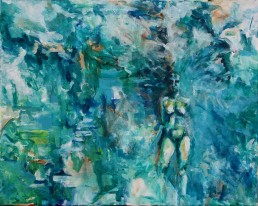
Joanna Frye, Untitled, 2017, Acrylic on Canvas
Sharks, Painting, and Patience
In our interview, artist and frequent ocean buddy Joanna Frye and I discussed the release from creative responsibility that comes with surfing. She said that when she surfed it felt like she was being painted instead of doing the painting. There is still plenty of creating going on when you surf or play in the ocean, it’s just not all coming out of your own limited human imagination and skillset. It’s not all dependent on your work. For those moments in the waves, you can’t even begin to lie to yourself about being in control of life, about dominating the world, or forcing an outcome. But you do, eventually, achieve some sense of control of your relationship to yourself and the uncontrollable.
Playfully, creatively tapping into a wider, deeper and, if you prefer, higher power is a practice that can, over time, change your mind and could do so, some neuroscientists think, by measurably changing your brain.
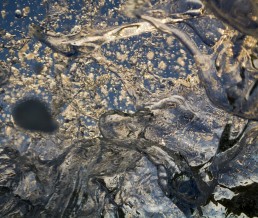
The research about the plasticity of our brains is thrilling but I don’t need a neuroscientist to tell me this: to catch a wave requires presence and acceptance: you can’t hurry things, or waste time thinking about the past or the future, or wish they were easier or more interesting. There just isn’t time for that. Not if you want to be there for that ride, to feel the rush and lift, and respond in whatever way your own body will allow, to be with that force for a delicious instant, to feel the joy of being on a planet with gravity instead of putting your creative energy into the futile task of working to somehow defy it.
One of the 20th Century philosophers I think is worth wrestling with is Maurice Merleau-Ponty. He wrote that “[t]rue philosophy consists of re-learning to look at the world.” It’s a pretty inclusive definition and seems to include those of us who are honest and brave enough to know that we need to revise our vision as we, our insights, and the world change. Merleau-Ponty’s work focused on that instant of perception, a sliver of time before our scientific, categorical mind can take over and begin to catalog, dismiss, prioritize, and judge. He thought this moment of perception was the beginning of all creativity, all art.
He wrote that “it is the expressive operation begun in the least perception, which amplifies into painting and art.” He also thought painters were uniquely well suited “amplifiers.”
Carolyne Quinn wrote a wonderful, accessible article about Merleau-Ponty’s work on perception and painting. Quinn writes that, for Merleau-Ponty “meaning is not found pre-existent in the world but is called into existence by the body’s own activity in the world.”
Merleau-Ponty’s work is more popular since his death than during his life because, as it turns out, his writing is more relevant to what we’re learning about our brains now than what we knew about them then. Think about it. If he’s even a little right, and we are dependent on our sensing bodies to help create meaning, what are our hyper-stimulated, scanning, swiping, fractured, and busy days doing, not just to our bodies, but to the meaning we call into existence in the world.
Quinn describes one of Merleau-Ponty’s most inspiring ideas, something called “reversibility.” Merleau-Ponty thought our body is both an entity that senses and an entity being sensed, and not just in the way your body is busy seeing and being seen by other partially dressed humanoids on the beach, but in the touch of a tree or a rock or a wave. You can be altered by the wave and the wave by you. Everyone who plays in the ocean knows this to be true. Merleau-Ponty just expands that intuitive understanding to encompass all perception. He thought that to understand either side of perception- being touched or touching, we needed to know they were not wholly separate, not either/or, and not one and the same. Instead, they overlap, both always part of any perception we have of the other. He thought most of us walk around with limited vision that ignores much of the rich, invisible depth of being sensed by the other. But not painters. According to Merleau-Ponty, while the rest of us (including photographers) couldn’t get at the real substance of perception, painters could render the invisible visible to the rest of us. Their paintings had the potential to render some of this fluid motion, this oscillation between seeing and being seen.
Because I live on the coast, because it’s the discipline at the center of my work and life, because it makes me feel sane, and is just too damn too beautiful to miss, I get in the ocean almost every day. A few weeks ago I hurt my rib in an unlucky fall and, while it’s been healing, I’ve been going in with my camera instead of my surfboard, photographing in the small, late summer waves each dawn and early morning. There are fewer black skimmers and the fish are starting to return in droves, each peaking shore break wave filled with dozens. My own species has begun its daily turtle walks. One one level, they’re out there looking for signs of nesting. But really, I think they are looking to call the meaning of hope into existence, walking with the hope that, for some perceiving moment in the future, they might dig a trench or hold a light that could help hatchlings, endangered as individuals and species, along their way. Even if they don’t save every turtle, they might save themselves.
Today, between sets of waves, a small shark swam from behind me, passing me on the right at a slow, leisurely pace— maybe there’s food aplenty. Rushing isn’t a priority. It must have seen me before I saw it, just so much inedible flotsam.The moment I saw its fin break the water, that instant of perception before I could categorize, the moment when my animal brain registered its size relative to mine (it was tiny, maybe 2 feet long), at its presence in the water, right there, with me, seeing me, and the resulting elation I felt at being seen (if it had been 2 meters long, I expect my perceptions might have been… different),— all reminded me of both Merleau-Ponty, and one of Joanna’s paintings that hangs on my wall, one that evokes something of immersion in liquid and light and motion, just like this morning. Reminding is a word we often say but don’t appreciate. To remind yourself is not just to recall, but to restore your mind to something valuable. I love that painting because it feels like the dissolution that happens to me in the ocean, the unimportant stresses and worries gradually losing concentration until they wind up just disappearing, and, even if they return, the wisdom and perspective that comes from the their intermittent disappearance endures.
Philosophers have been imploring us for a long time to learn to accept what we can’t change. The Stoics of Ancient Greece did it. Some Buddhists did (and do) it. The Serenity Prayer does it. But most of us still suck at it: quick to irritation or anger or a wish for a trap door into which you might dispense with or exchange the reality of the aggressive driver, the glitchy gadget, the broken rib- there are so many situations in our daily lives that regularly, reliably immerse us in stress, even when everything’s going “right.”
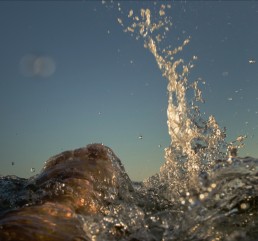
As soon as I realized my rib was well and truly hurt, that I might miss weeks of surfing these beautiful summer waves, I panicked. I didn’t want to miss waves. This was a disaster.
A minor one my brain scolded.
My feelings did not obey.
I began to focus on speed healing. Googling nutrition and bone injuries, stocking up on vegetables with Vitamin K (green cabbage has twice as much as red), doubling up on magnesium supplements, uncovering the miracle of comfrey (which is pretty miraculous). Maybe it was just a bad bruise and would be surfable in a few days?!? A couple of false starts over the next week helped me settle in. As a wise yoga teacher once told me, “If you get into a fight with your body, you are going to lose. Every. Single. Time.” Recovery would take exactly as long as it would take.
One of the primary, foundational motivations for this Waves to Wisdom project is finding ways to let others in on one of the central, grounding, and most useful working theories I’ve figured out in a long time spent figuring: our bodies and their perceptions are primary to what we create. What we experience when we are at play and deeply at home in our bodies, when these bodies we all have feel integrated into, even continuous with our larger home on the planet– these moments can be lessons that recast our lives; even the objects, people, and relationships that seem utterly familiar to us. We can perpetually see them anew and, in turn, be renewed in their eyes. The ocean is one particularly exciting and beautiful way to learn these lessons.
If, on the other hand, we spend all of our time scanning, slouching, and constricting, or dominating, forcing, and demanding, we can’t help but create meaning and methods to match. We value what will entertain or enrich us in our slouch instead of allowing ourselves the benefit of experiencing life elongated, expansive, fully oxygenated, and open to what’s right here and far away, open to the interdependence of self and other. We all sometimes allow the endless stream of information and news and wellness advice to overwhelm this moment, the only one we have, the one we don’t get back, the one in which someone nearby, a tree, a turtle, a neighbor, maybe even we ourselves, could benefit from some awareness of seeing and being seen.
That shark was today’s teacher and the painting it somehow called into my awareness the fortunate ongoing reminder of the lesson. I’ve been looking at it for a long time but I saw it anew today and it wasn’t anywhere in sight. I realized, without words, with the flick of the tip of undulating fin and tail, why I’ve loved it so much. That instant of sensing, of being sensed, being part of what Davis Abram calls “the biological matrix of life on the planet,” and being a person fortunate enough to return to walls and art and one painting in particular, was an exquisite episode of “reversibility.”
I owe that “unlucky” fall for the gift of this day sitting at my desk, rib healing, with the painting about as far away as the shark was, seeing me see it with reminded eyes.
For us too, if there’s enough food, maybe rushing doesn’t need to be a priority.
For information about retreats or to set up a free coaching session email maia@wavestowisdom.com.
Sources
Abram, David. “Merleau-Ponty and the Voice of the Earth.”Environmental Ethics, volume 10 (1988), pp. 101-120.
Cheron, Guy. “How to Measure the Psychological ‘Flow’? A Neuroscience Perspective.” Frontiers in Psychology 7 (2016): 1823. PMC. Web. 31 Aug. 2018.
“Maurice Merleau-Ponty (1908-1961)“. The Internet Encyclopedia of Philosophy
Staiger, Christiane. “Comfrey: A Clinical Overview.” Phytotherapy Research26.10 (2012): 1441–1448. PMC. Web. 31 Aug. 2018.
“Stoicism.” The Internet Encyclopedia of Philosophy
Quinn, Carolyne. “Perception and Painting in Merleau-Ponty’s Thought.” Paris III, Université de Sorbonne-Nouvelle/University College Dublin
Why a Waves to Wisdom Retreat?
August 21, 2018Ocean as teacher,Retreats
purpose (n.)
c. 1300, “intention, aim, goal,” from Anglo-French purpos, Old French porpos “aim, intention” (12c.), from porposer “to put forth,” from por- “forth” (from Latin pro- “forth;” see pur-) + Old French poser”to put, place” (see pose (v.1)). On purpose “by design” is attested from 1580s; earlier of purpose (early 15c.).
clarity (n.)
c. 1300, clarte, clerte “brightness, radiance; glory, splendor,” from Old French clerte, clartet (Modern French clarté) “clarity, brightness,” from Latin claritas “brightness, splendor,” also, of sounds, “clearness;” clarare “make clear,” from clarus “clear”
From etymonline.
“What is it that you plan to do with your one wild and precious life?”
If you already know this line (and the Mary Oliver poem that ends with it), when did you learn it?If you don’t know it, it’s copied at the bottom of the page. Read it (preferably several times) when you’re through with the post— you won’t be sorry.
For me, that question, instead of demanding an answer, cleared a lot of automatic junk answers out of the way. The poem left me with a new view, informed by vastness, as well new dimension of understanding about attention to the particular. The full-bodied sensing and responding to ephemeral minutiae that began with (but didn’t stay limited to) my longtime photographic practice was, or at least could be, sacred.
But this alteration in vision didn’t happen immediately. This is a question to be lived, to embody, not just to answer. I encountered this poem in the late 1990s. Where were you then? Oliver’s poem gave me language that, with silent repetition, let through a sort of light that left everyday choices looking different, altered, more abundant, and less prosaic. It gave me a kind of faith to take on a designer’s role in my own life to keep asking the question of myself, my choices, and most of all, the consequences of those choices. Then, when necessary, course corrections where just revised, renewed, perhaps wiser ways of asking the question.
But, as I said, this was in the 90s. I was living in a world where you still chatted with the person in line behind you with your mouth, not your thumbs. You went home from work and didn’t mindlessly keep tabs on what people at work were emailing, posting, doing, not doing. Maybe you took your book to bed but taking your phone to bed was not a thing. There seemed to be more time then. Less to do and more quiet to contemplate the reasons to do the things one did undertake.
It wasn’t a Golden Age but it was a more spacious one. I’m wary of prescriptions and recipes of all sorts but I know this, taking some time from the habitual reactions to the demands of others is a crucial practice for maintaining and accessing creativity, peace, clarity, and purpose. For me, it’s always involved moving my body and letting my mind open— on long bike rides, runs, walks, hikes, swims, yoga sessions, and, lately, surfing. There are a lot of ways to learn to listen to the deep wisdom of your embodied intelligence and the silent, powerful questions and metaphors it’s asking you to consider every day.
I began guiding Waves to Wisdom retreats out of a desire to give you an opportunity to turn off Facebook and email and, for one precious, abundant week, put your own direct, rich experience of the world at the center of your days. It’s intentional time in an exceptional setting with space to reflect on what you are sensing, how it offers new perspectives on your life, and to develop language for these insights. It’s a chance to give voice to dimensions of purpose that might be hiding in plain sight. How do I know this will work for you? I can’t know that but, as you are reading this, I bet you know, even if it (especially if) the prospect sounds a little bit daunting, or downright scary.
We use beginner surf lessons, yoga, and reflection as ways to for each of us to mindfully inhabit our own bodies, to put our internal editors on mute for just a moment, to experience the unbridled joy of childhood when falling down wasn’t a disaster and practice (whether it was a favorite sport or a beloved instrument or even a favorite video game- Pong, anyone???) was a time for playfully pursuing improvement and not a way to “make perfect.” For the upcoming retreat in Costa Rica in March, we will spend he majority of each day resting, and reflecting. We will explore a bit of the lush, open hearted jungle community of Nosara and spend time in coaching sessions to abundantly nourish the wisdom that emerges from the experiences.
This morning, before writing this post, I called up one of the past Waves to Wisdom participants who, while loving the ocean play, decided she didn’t like surfing so much after all. I wanted to know what she’d learned from the retreat. With no hesitation, she said “clarity and purpose.”
These are, to my 50-something self— exceptionally demanding and often overwhelming times. There is so much wrong, so much at stake, so many ways to act. Time staring at the line where ocean and sky meet has been more important than ever for me to gather the strength to act. and the perspective to figure out, given who I am, what sorts of action make the most sense. In other words, clarity and purpose. At the heart of my purpose is a decades long practice of crafting ways to guide you into a deeper connection with yours.
If you come on a Waves to Wisdom retreat, you will play in some waves and, more importantly, you will take some time to stare at trees, watch the monkeys and iguanas, write some lines to yourself or make some photographs to help you guide your attention. This experience is transformative. But what transforms?
For one thing, your words change. As you allow the daily dose of sunrise over the green, enveloping, jungle-covered arms of land that hug Playa Guiones’s gently sloping, sandy beach to work their magic on what you notice, and how you give voice to that attention, as you carry our daily questions through the resting hours of hammock time, and the excitement of exploring Nosara’s bumpy roads and jungle paths, when you’re not even trying to find an important revision to a stubborn case of being stuck, one might just come to you.
You will return home with thoughts transformed by green waves whose water somehow dissolves the artificial barriers between your perceived options and your own purpose. In our world bounded by walls instead of seasons, ocean play is the most direct path I know to access the hidden, embodied intelligence that is likely right there, with you when you fold yourself into a chair or force yourself to the gym after a long day at work, or just collapse into the couch to watch Parenthood… again.
What won’t matter on this retreat is whether you ever stand up on a surfboard, or even decide to take one out with you. All that matters is your capacity to close your laptop, open your heart, get a little wet, and commit to yourself. Oh, and let go and have some fun!
The next opportunity for a scheduled retreat is March 3-10, 2018 in Nosara, Costa Rica. Early bird pricing ends September 15th. To inquire about custom retreats for your group, business, or organization, email maia@wavestowisdom.com.
